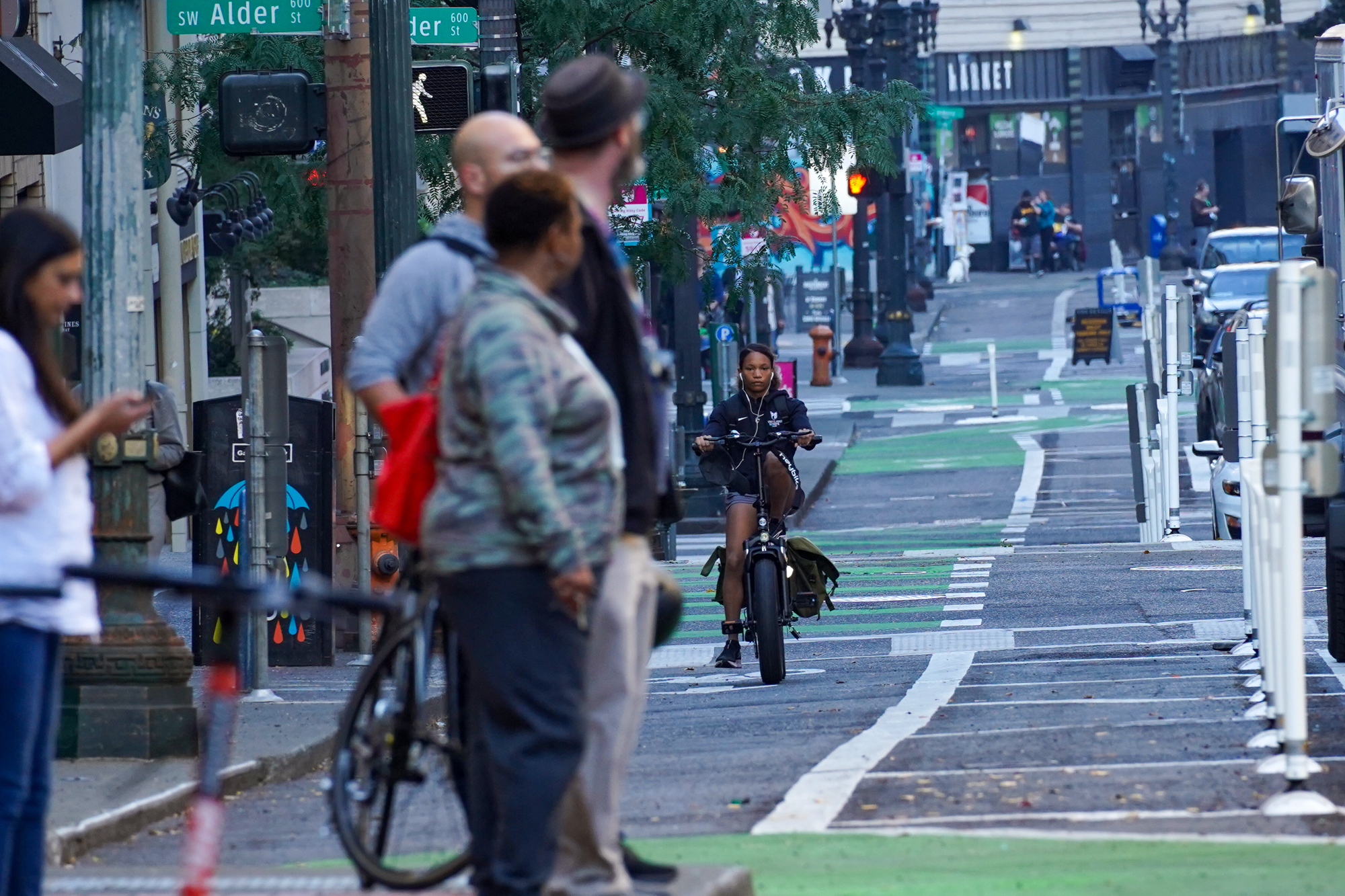
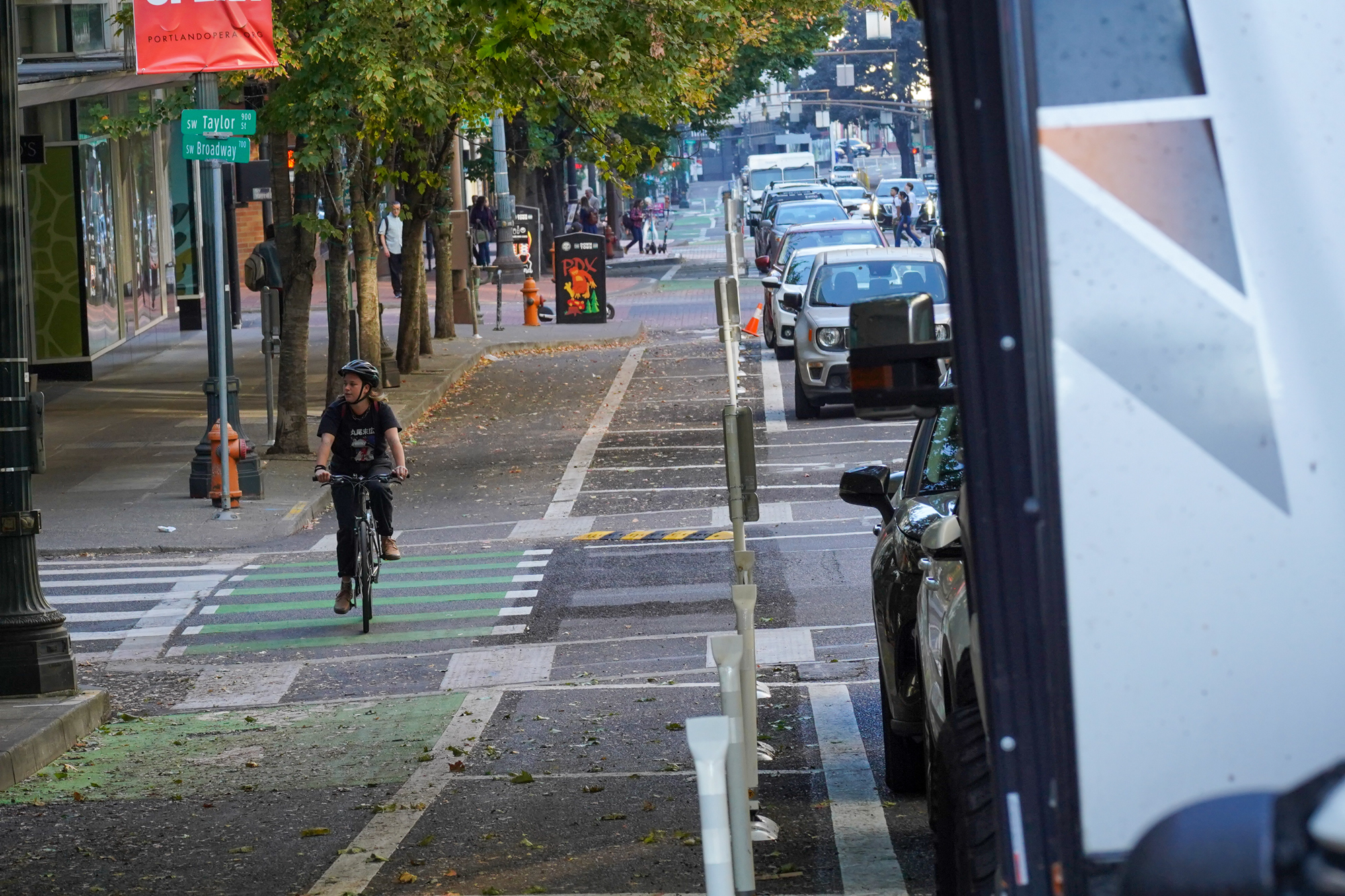
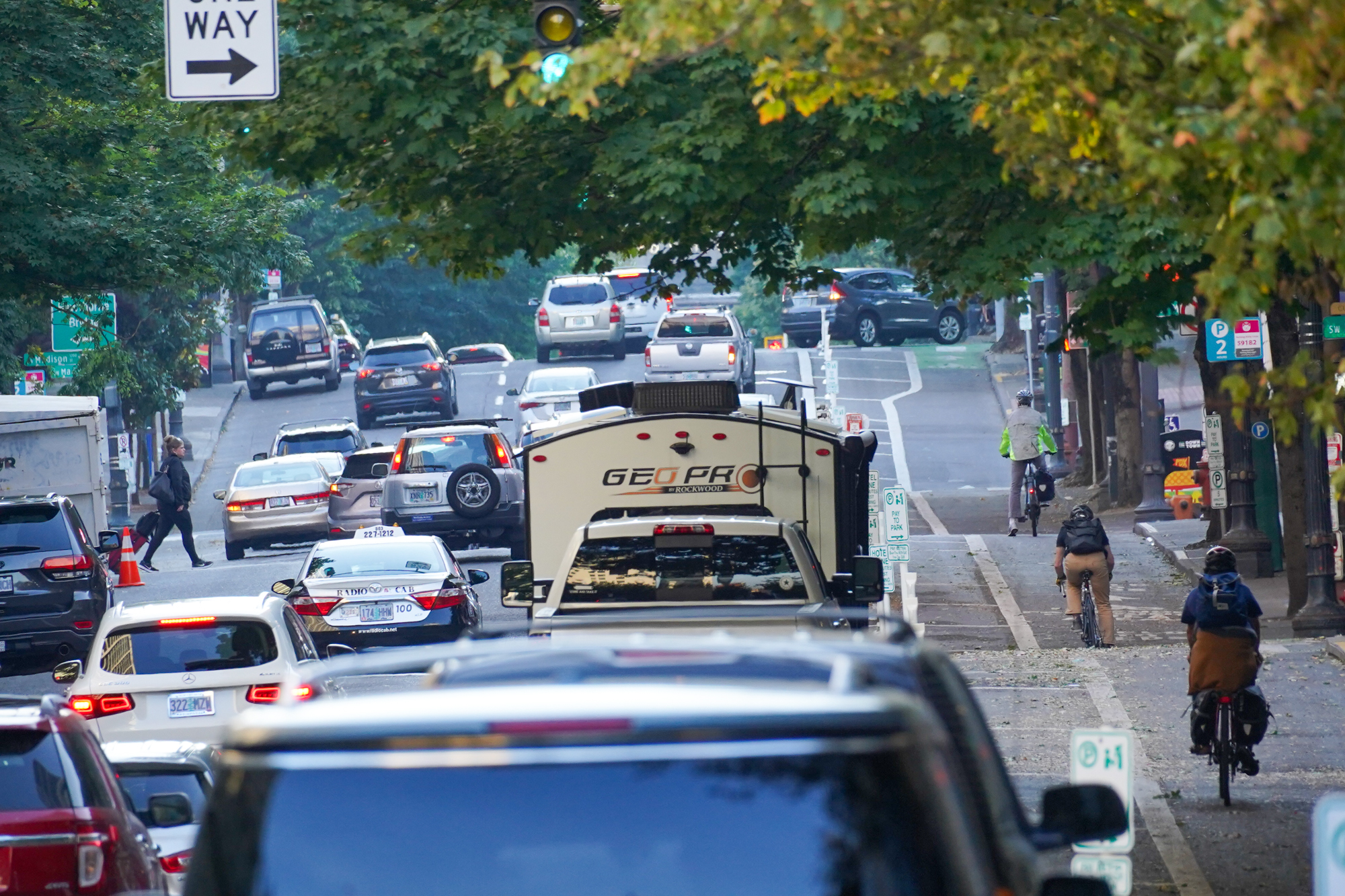
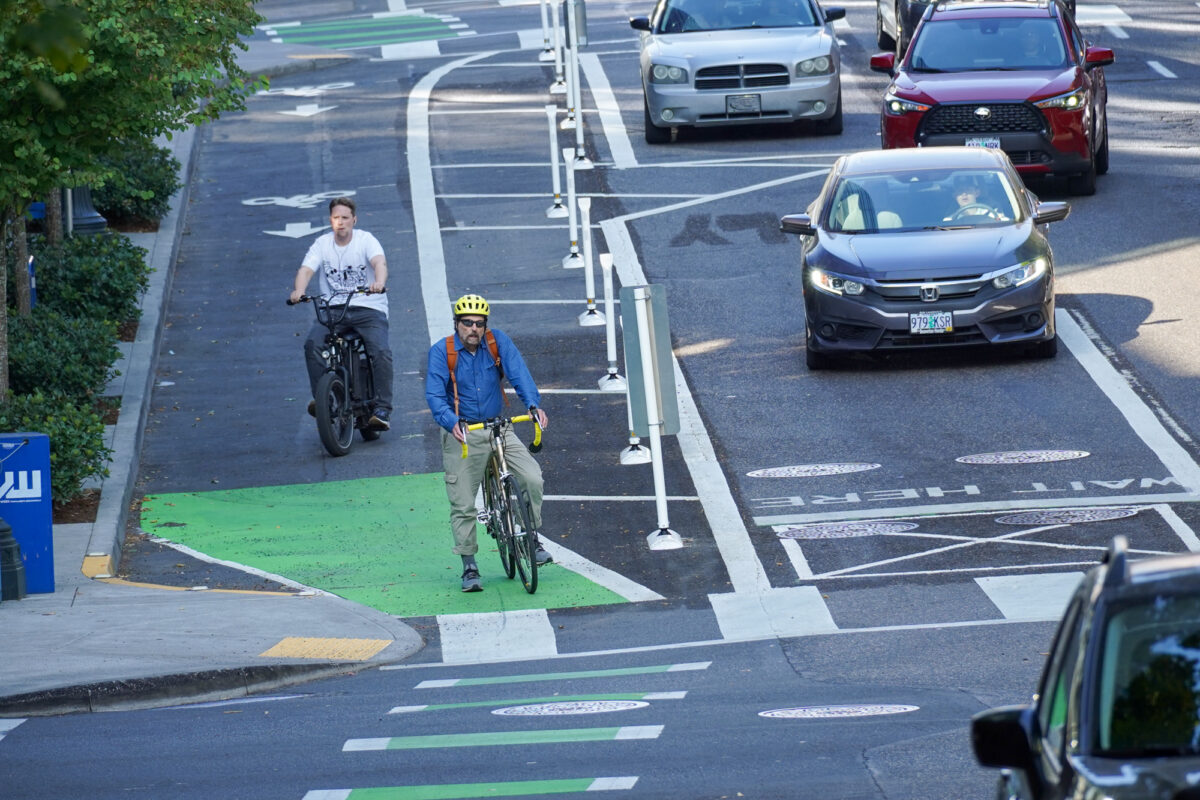
In April 2009, newly elected Mayor Sam Adams made a big announcement at conference held at Portland State University. He would oversee the installation of Portland’s first major “cycle-track” — what we now call protected bike lanes. Initially planned for the North Park Blocks, Adams switched the alignment to Southwest Broadway to avoid “intractable” pushback from the Portland Fire Bureau. The bike lane opened four months later and the rest was history.
Unfortunately, Adams only striped the most politically convenient segment; one that was entirely adjacent to the PSU campus and that had no driveways or busy cross-streets. The bike lane only lasted about 0.3 miles from SW Clay to Jackson (just before I-405, see map at right).
From the very start, the Portland Bureau of Transportation promised that this new protected cycling lane would extend all the way to the Broadway Bridge. But it would take 11 more years for the next segment to be installed. We got another 0.4 miles — from NW Hoyt/Broadway Bridge to Oak — in November 2020. As nice as that was, the most high-profile section of Broadway was still an embarrassing and stressful door-zone bike lane (see before photos below).
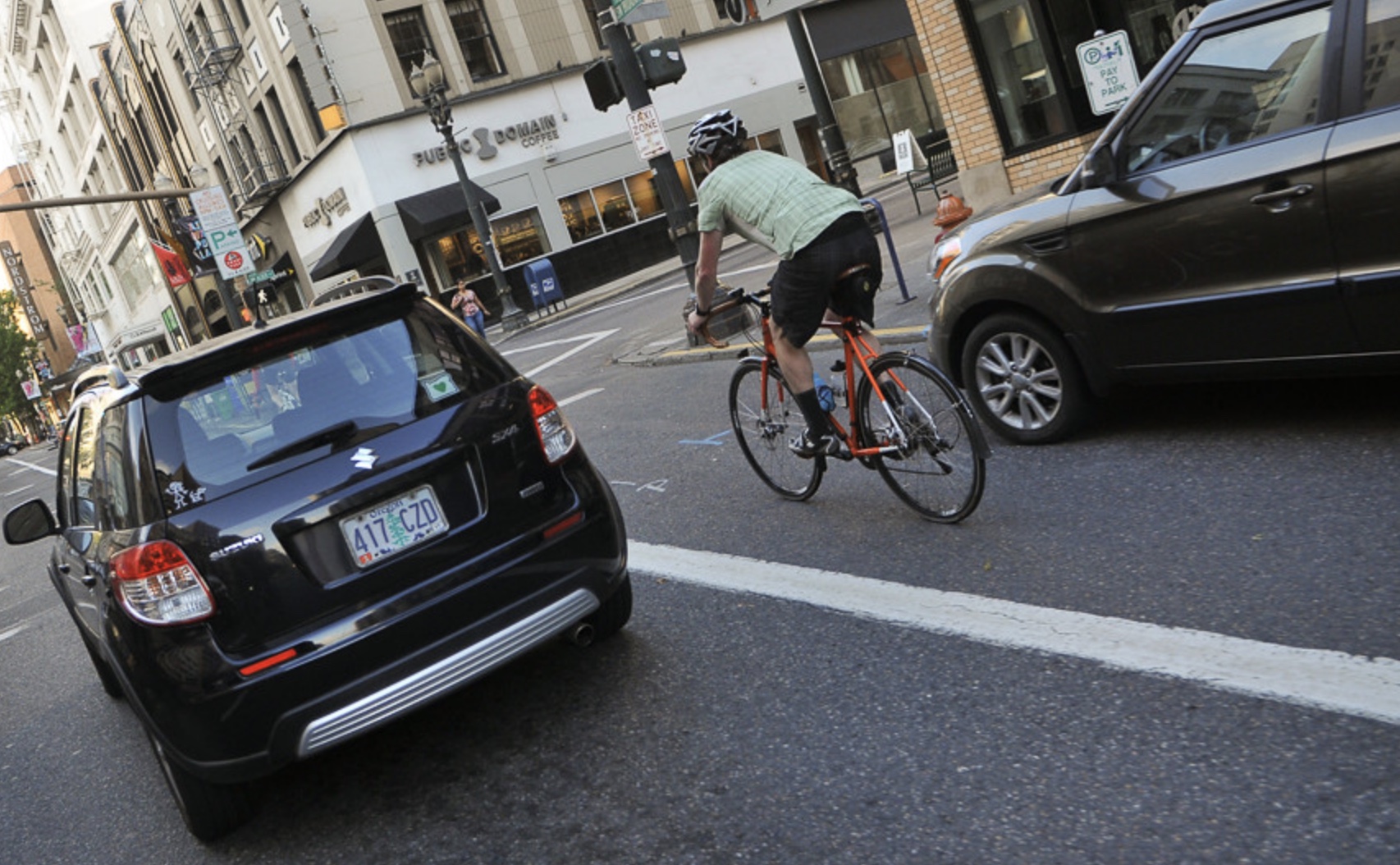
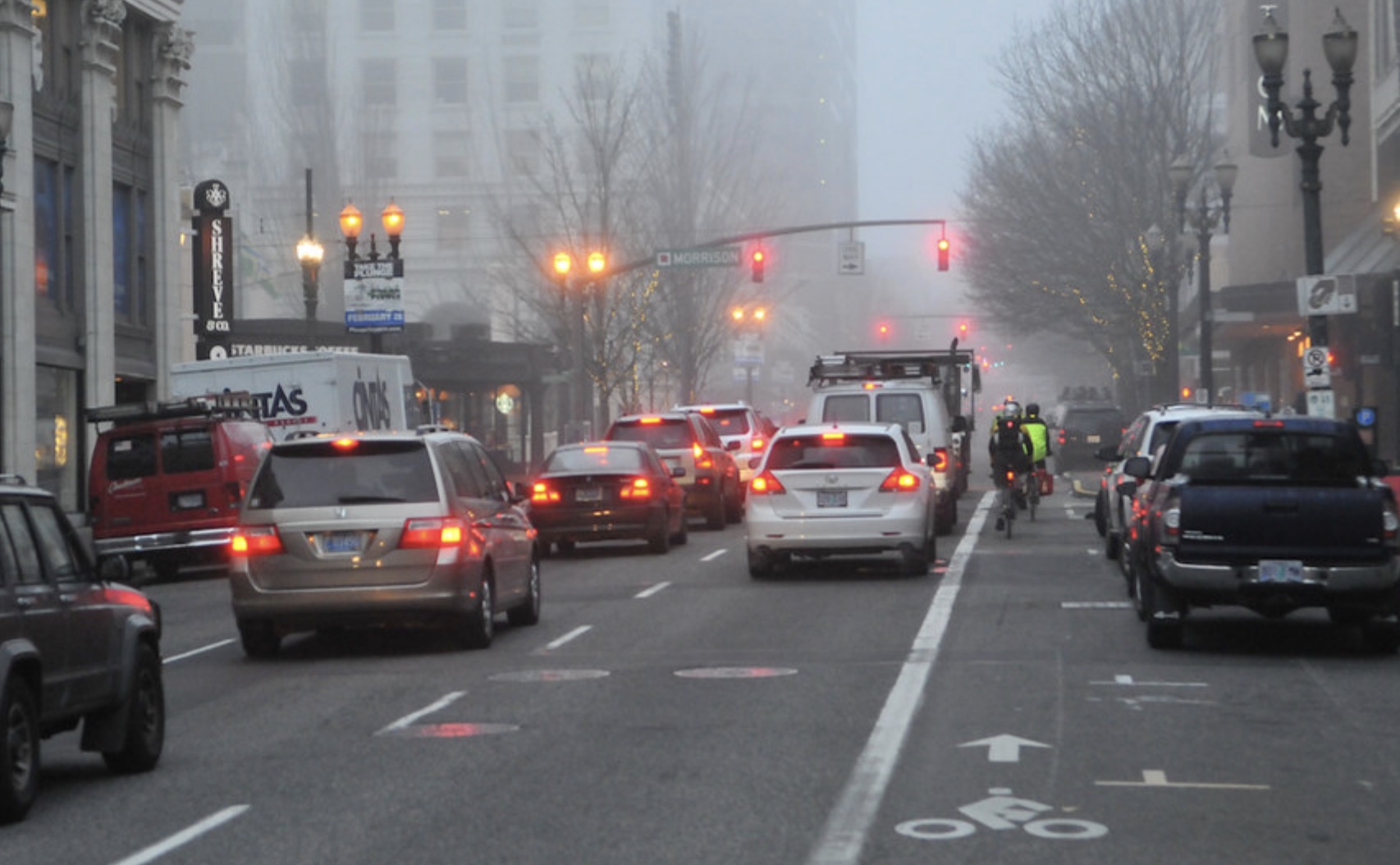
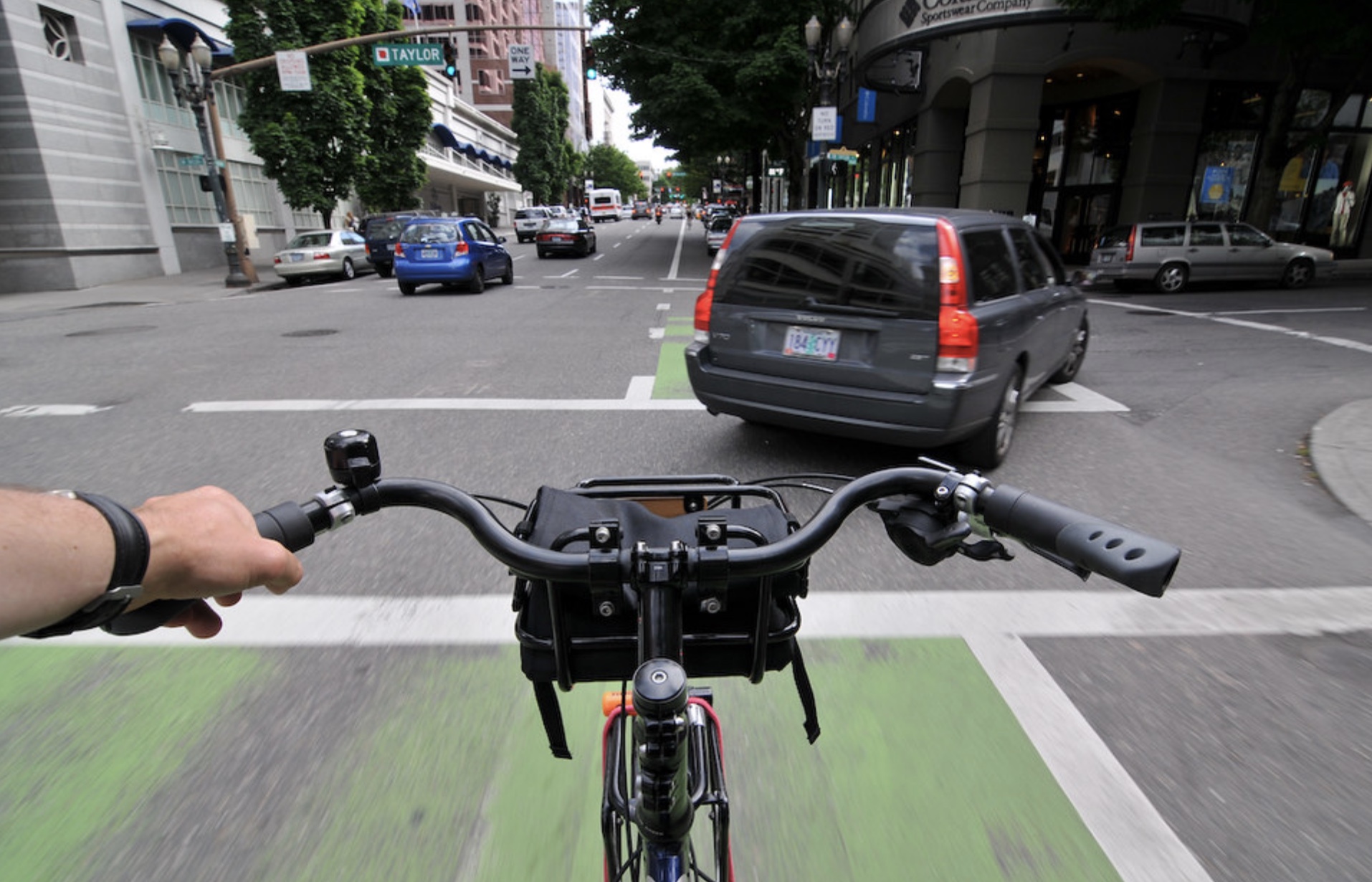
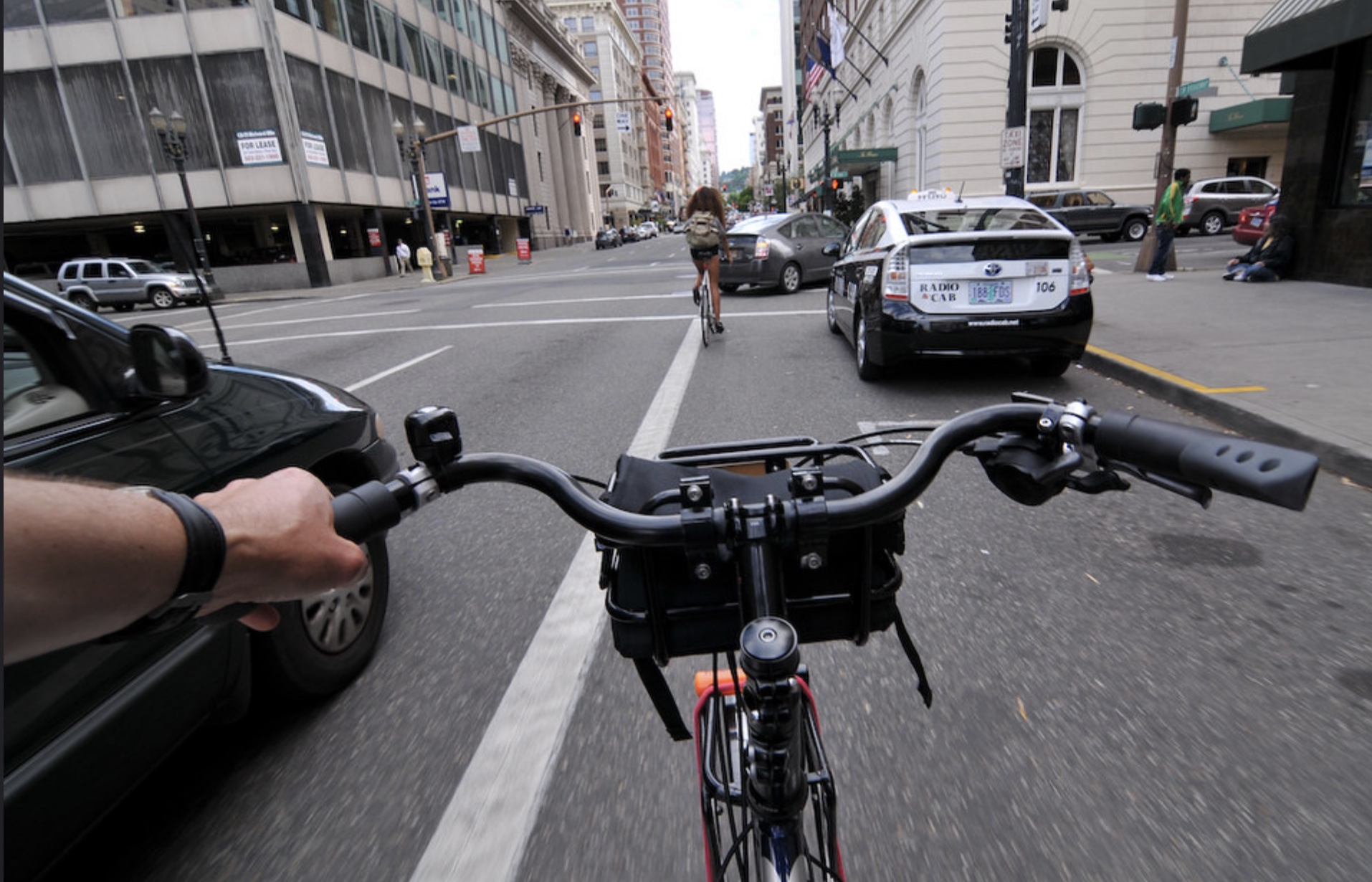
In 2016, a group of planners (one of them, Nick Falbo, who now works for PBOT) did a pop-up demonstration project called “Better Broadway” that shared a vision of what a protected bike lane could look like. We don’t have to imagine any longer!
Now, 13 years after the first segment was built, we’ve found our missing piece: There’s a continuous, (relatively) high-quality parking-protected bike lane for the entire 1.3 miles on Portland’s marquee downtown street! And PBOT saved the best for last!
I took a closer look at the project Monday afternoon and came away impressed and happy.
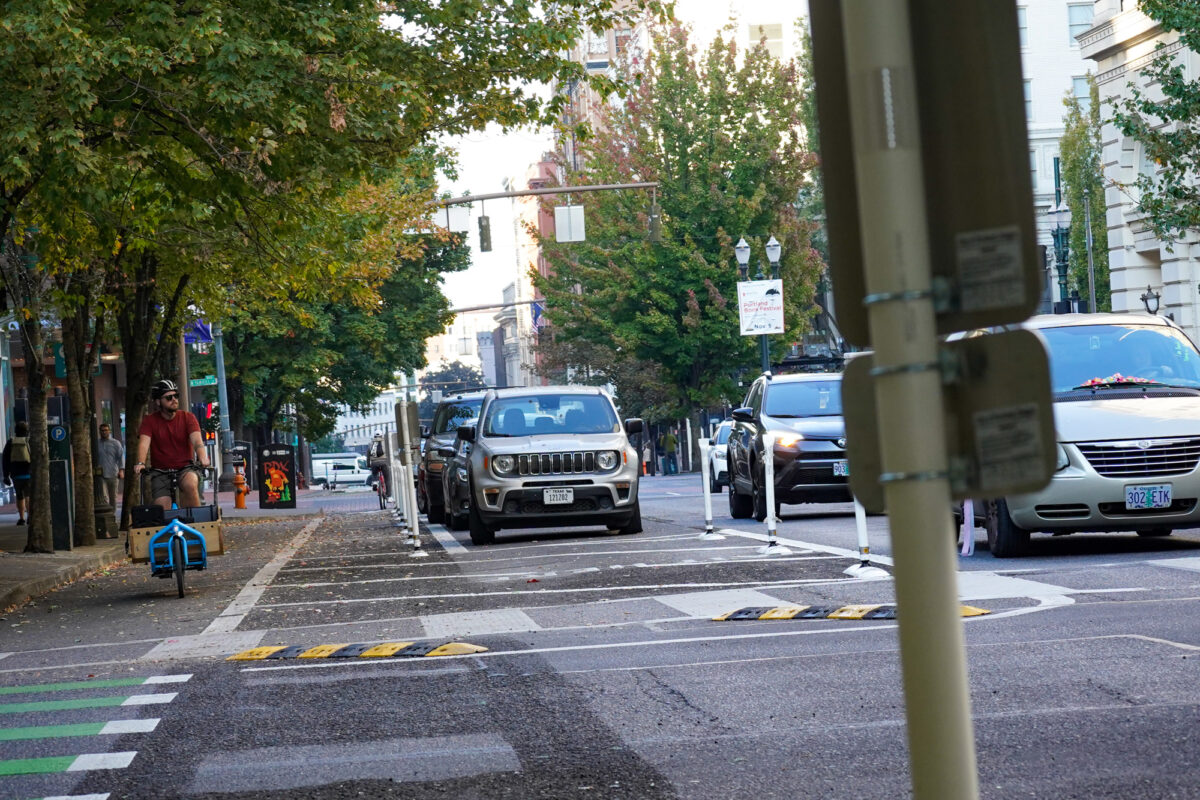
By now we’ve seen this striping pattern all over the city. The new bike lane is curbside and drivers can park cars in a floating parking lane that’s in the street. Those parked cars, along with a buffer zone, create protection between bike riders and other traffic. Besides the opening of car doors, the other main hazard on Broadway before this bike lane went in was right-hooks. PBOT had installed green bike boxes at the most problematic corners (like SW Taylor and SW Washington), but the risks never went away.
Now there’s even more space between right-turning drivers and bike riders (see below). And it felt and looked much safer to me. At the intersection with SW Columbia, there’s the bike lane and a very wide buffer to the nearest other lane. At Taylor and Washington, PBOT has installed traffic-calming curbs in the corner in addition to space. It’s all in the name of safer right turns. As you can see in the photos, drivers now turn so far from bike riders, and at such a sharper angle, that they are almost staring directly at the bike lane by the time they cross it. This is excellent visibility and makes right-hooks much less likely. (PBOT has also added green coloring to the bike lane at crossings and other potential conflict zones.)
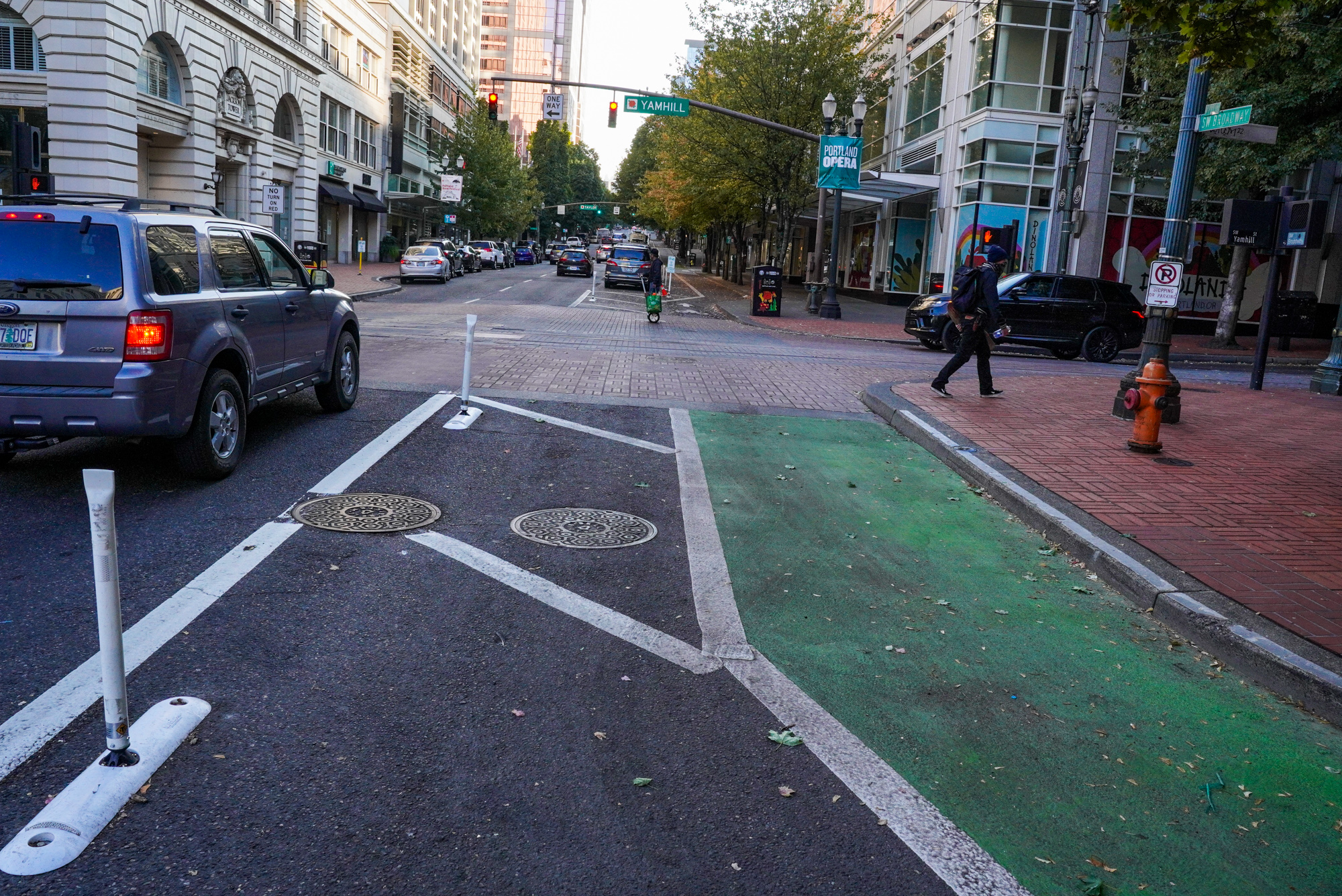
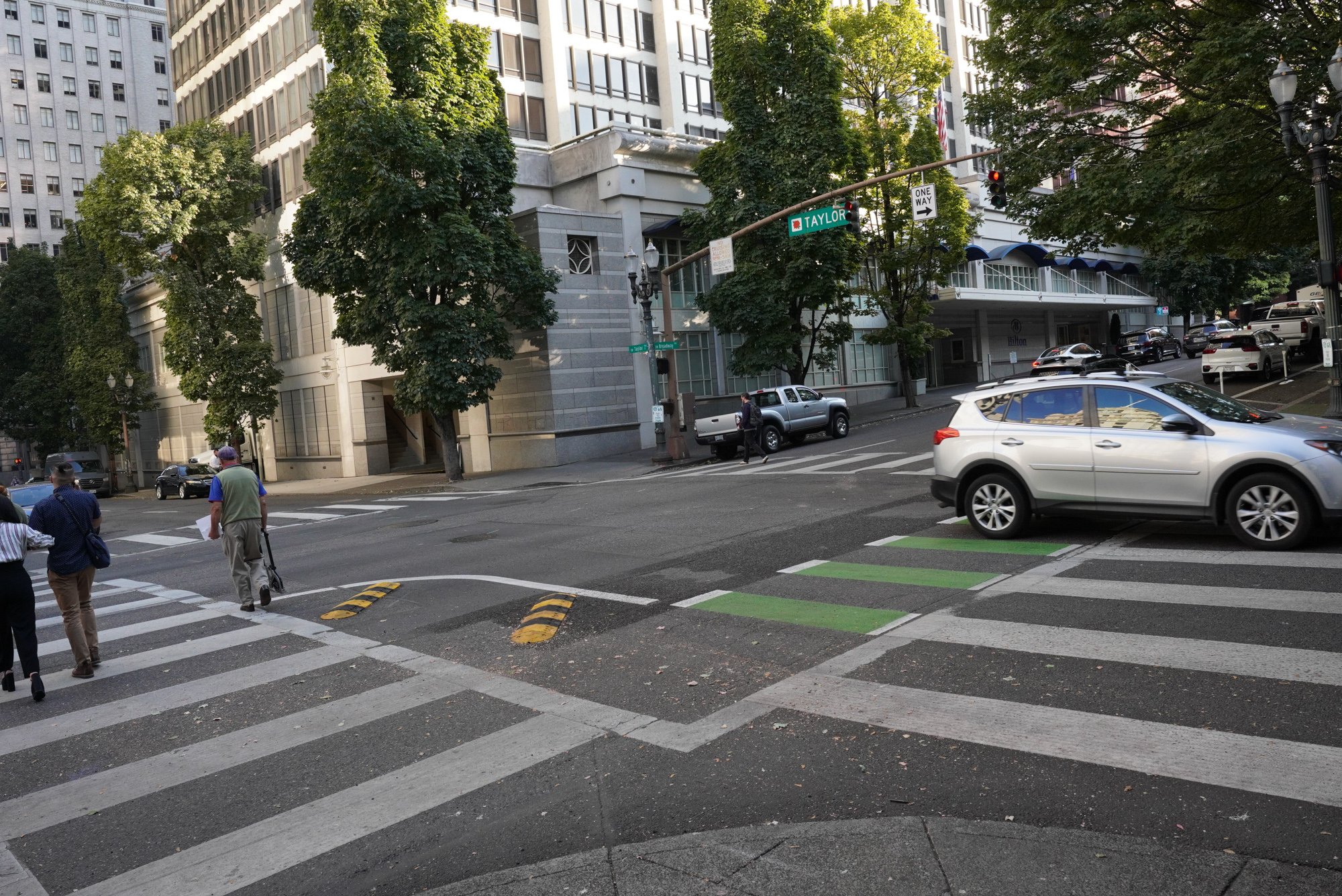
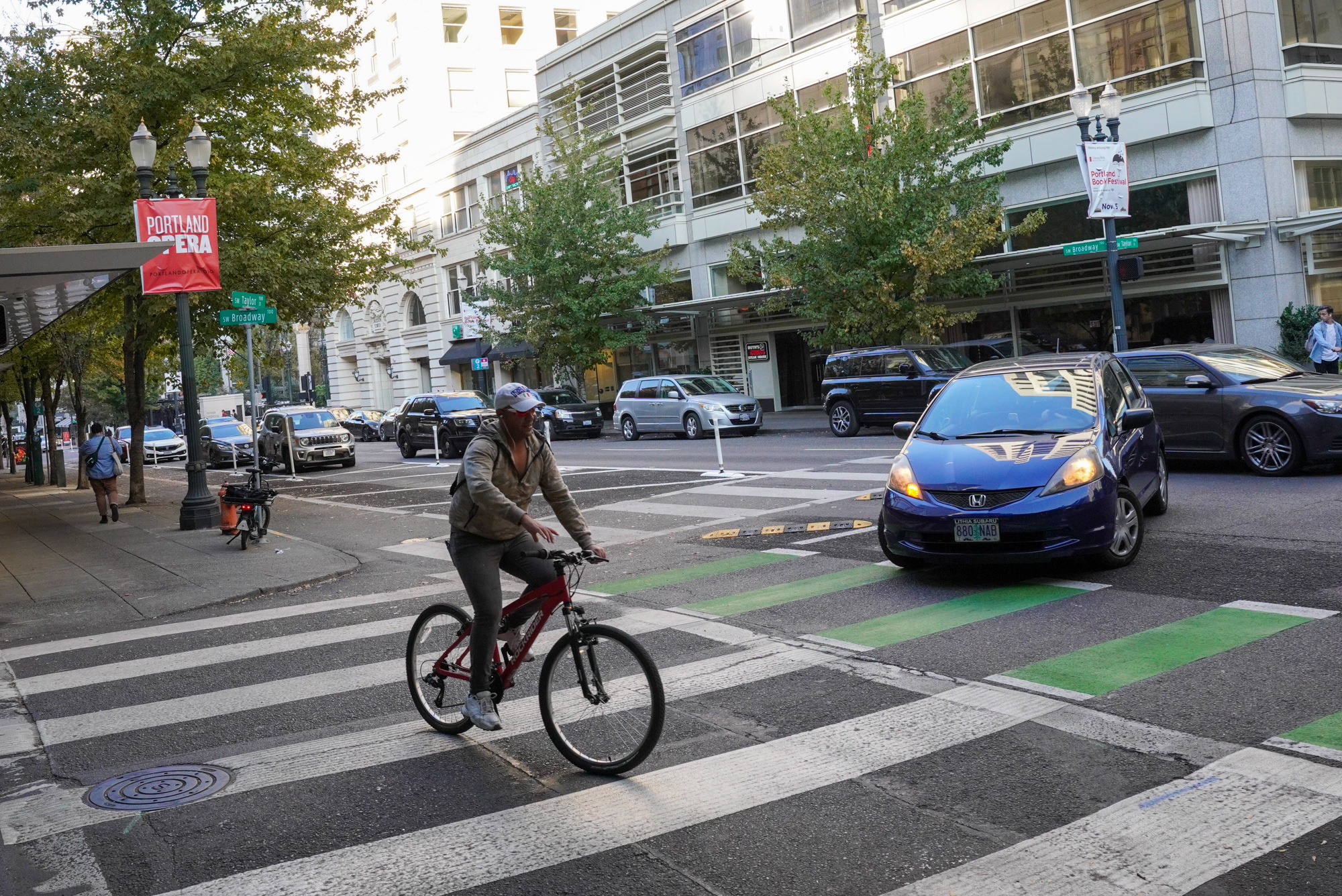
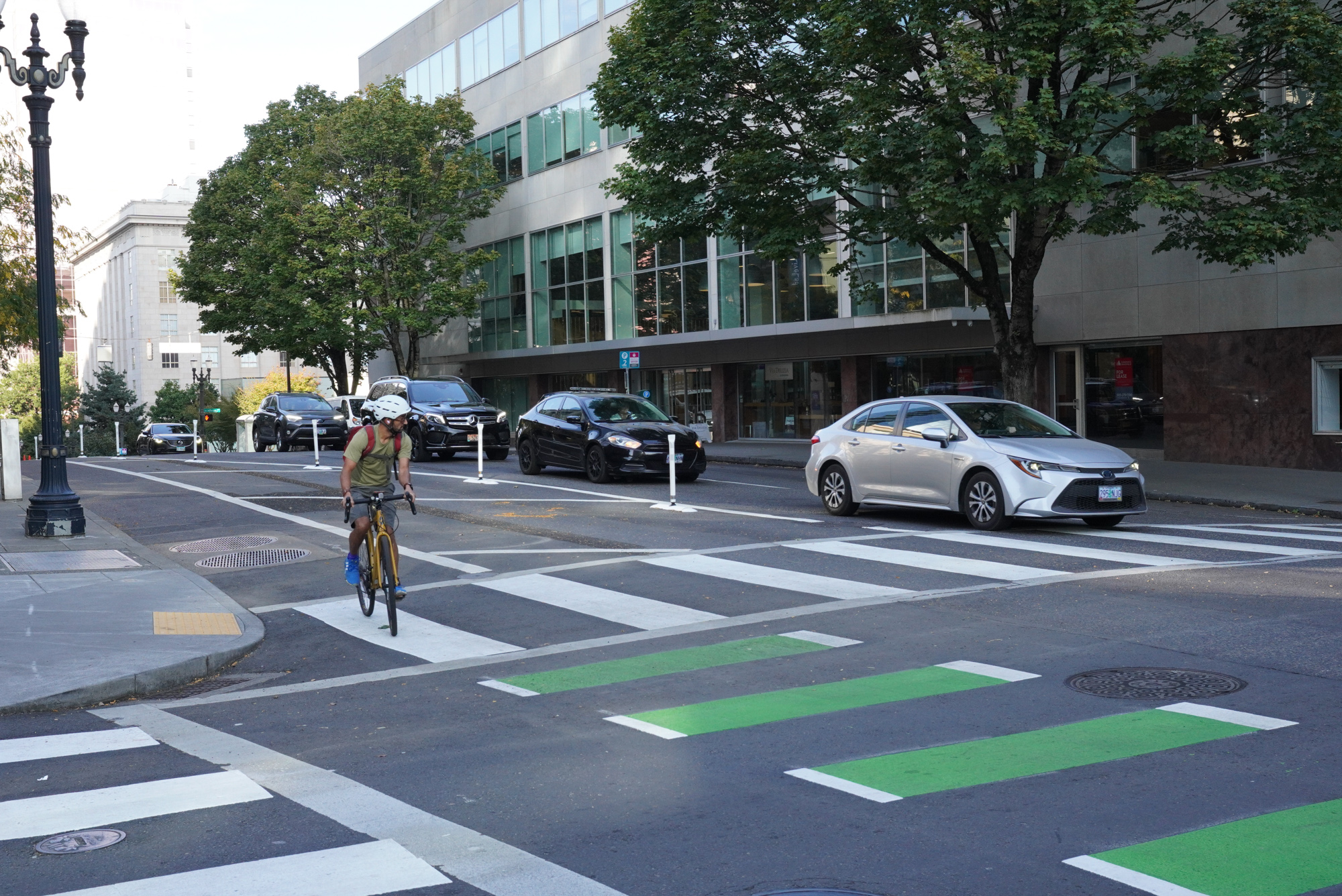
The design does so much more than protect bike riders. Because moving car traffic is now about 20-feet from the curb, there’s a much quieter and calmer feeling on the sidewalk. This means hotel, shop, and restaurant customers — and everyone moving around outside of a car — have more space to spread out and cleaner air to breathe. I bet sidewalk cafe seating, like the espresso stand outside Nordstrom, will become much more popular. This protected bike lane also creates a protected sidewalk. And because there’s less driving space, the crossing distance is significantly shorter and safer.
And since we’re not at Amsterdam levels of bike traffic yet, the bike lane won’t be full all the time. I personally have zero issues with non-bike riders using the bike lane space when it’s safe and polite to do so. I think we should even be cool with courteous bike riders going the opposite way in the bike lane, instead of using the sidewalk, to reach their final destination.
But while PBOT has reduced the space for drivers, they still have plenty of room to operate. Despite how some haters try to spin this, look at the photo below and you’ll see a streetscape that remains largely dominated by cars:
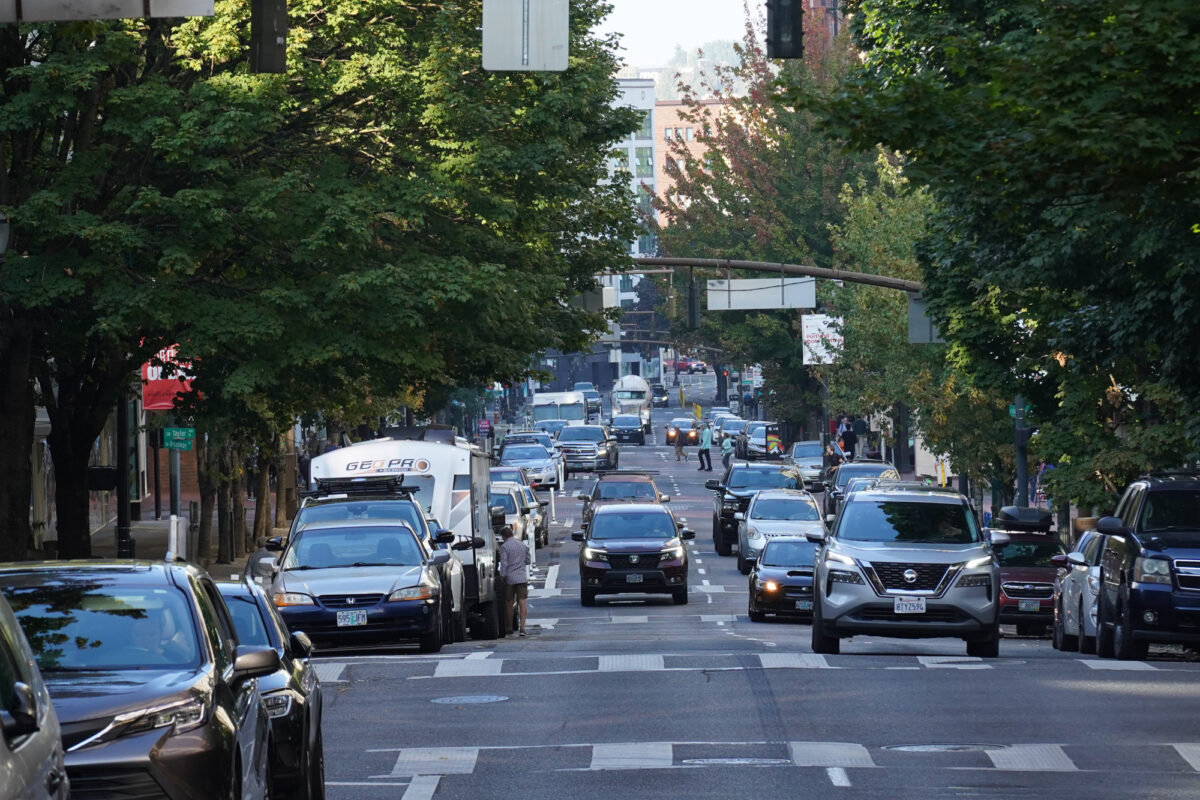
Speaking of which, we need to talk about the two hotel zones. I think one reason this segment took so long to get done was because PBOT was afraid to deal with owners of The Heathman and The Benson hotels. From my observations this is still an issue to track. At The Heathman I saw several drivers park in the bike lane, despite very clear “Hotel Zone” markings on nearby sign poles and in the bike lane. Fortunately, instead of before when double-parked cars would require bike riders to swerve into active traffic lanes, it’s now possible to squeeze by two parked cars. While still annoying and risky, at least you aren’t likely to be hit by a moving car. And if hotel staff and PBOT parking enforcement continue to monitor this, it should be a non-issue as folks get accustomed to the new rules.
Have you ridden this yet? We’d love to know what you think. Especially folks who rode it a lot before the changes.
Check out the rest of our photos below:
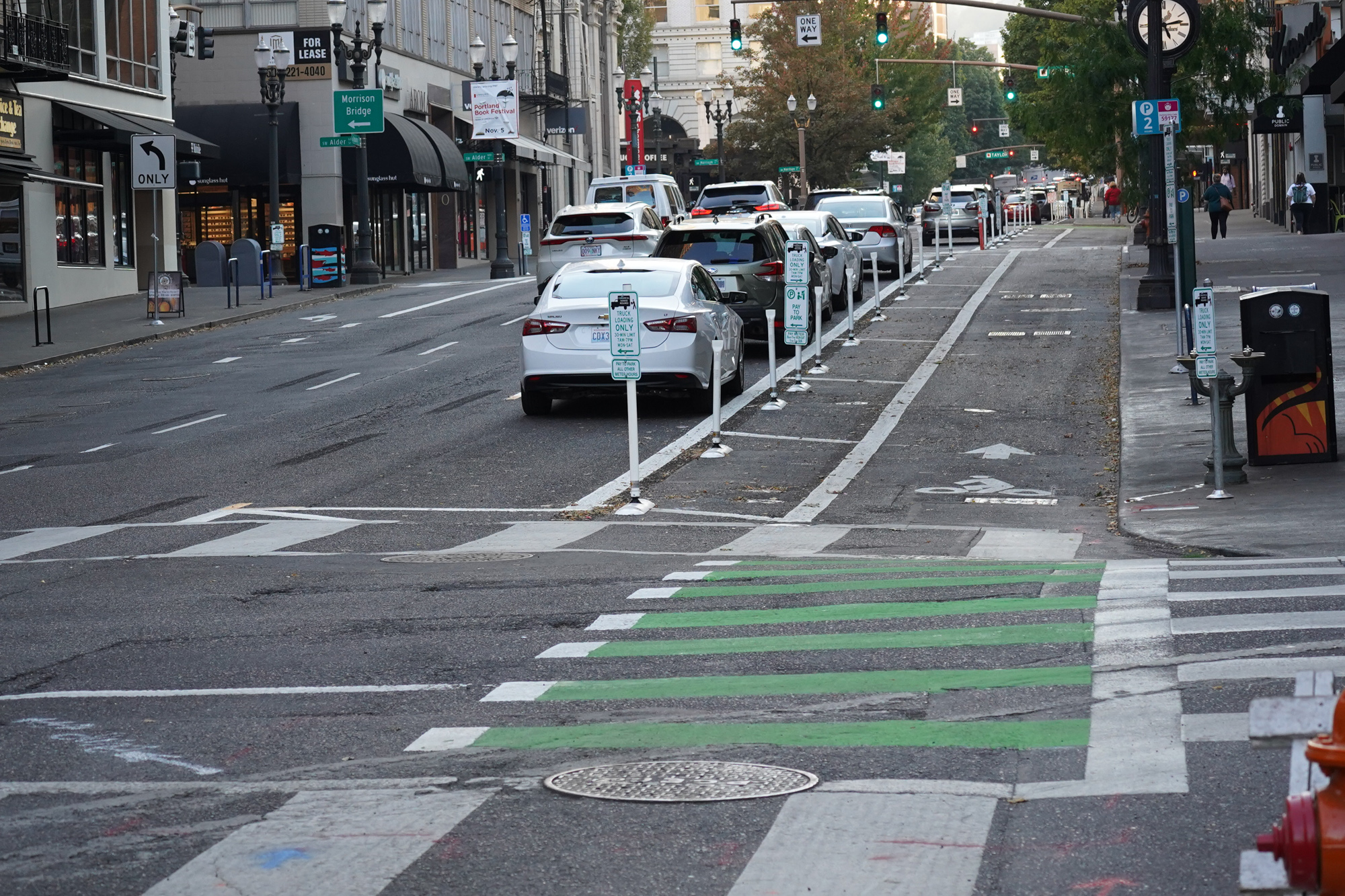
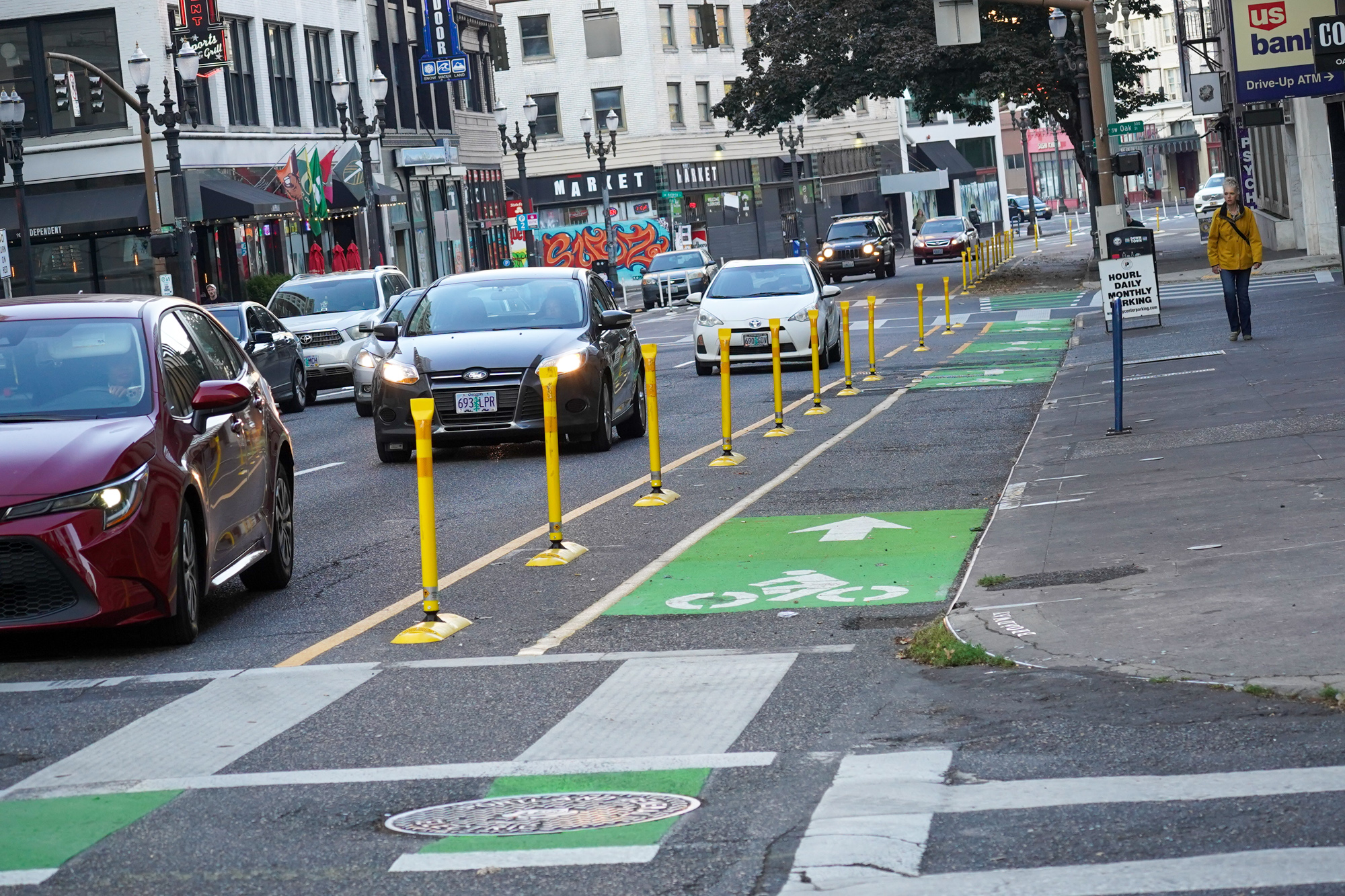
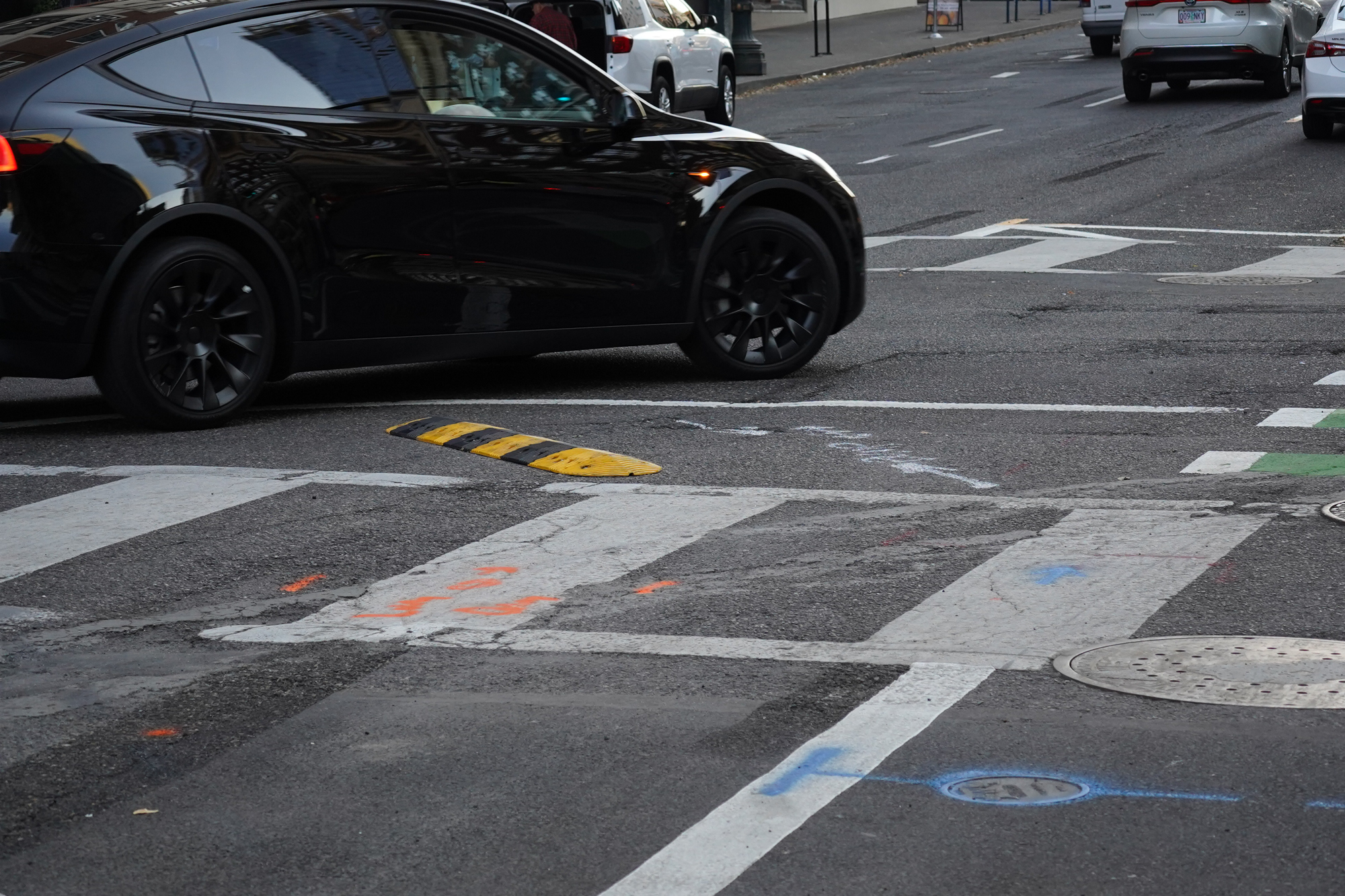
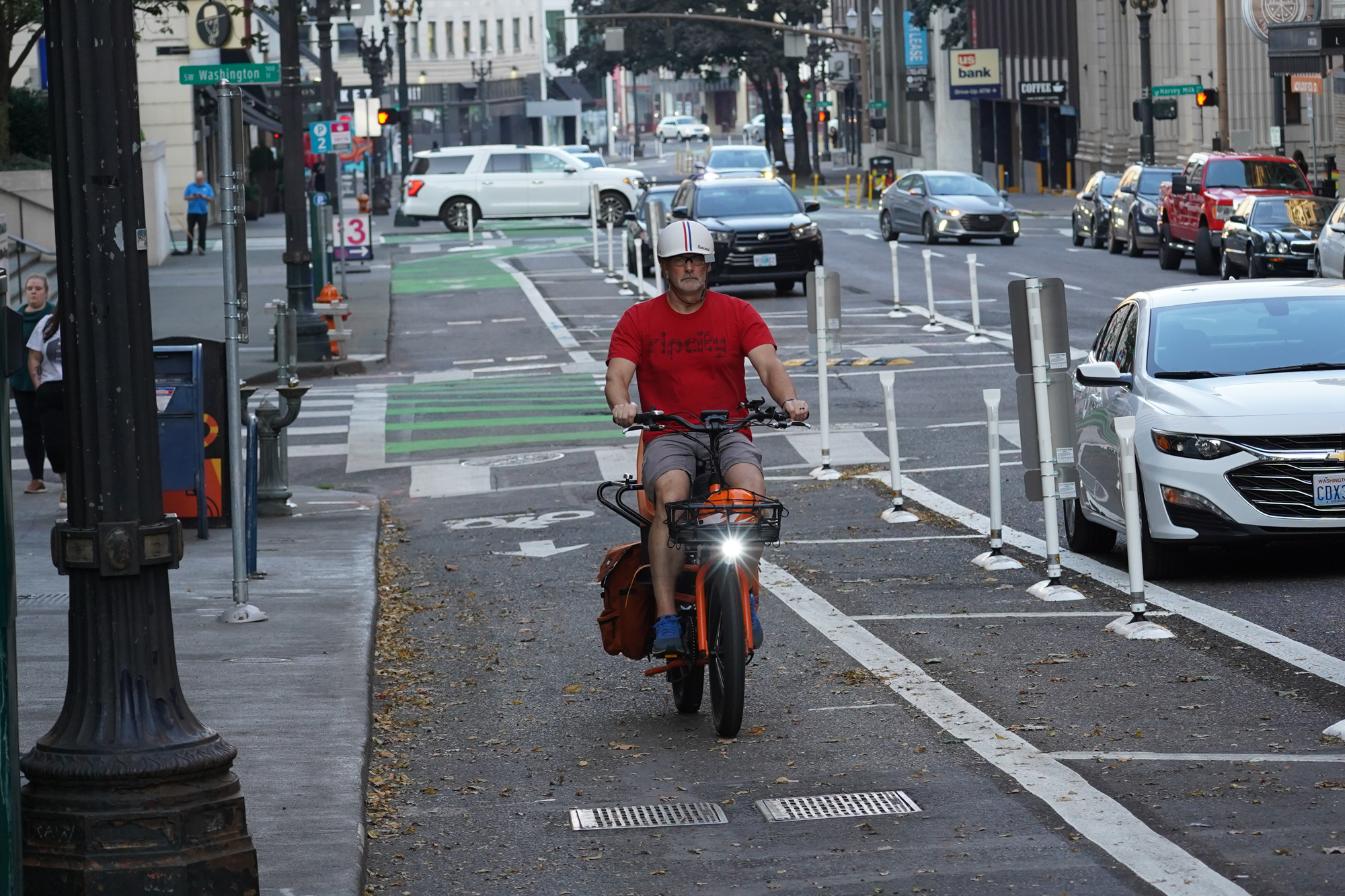
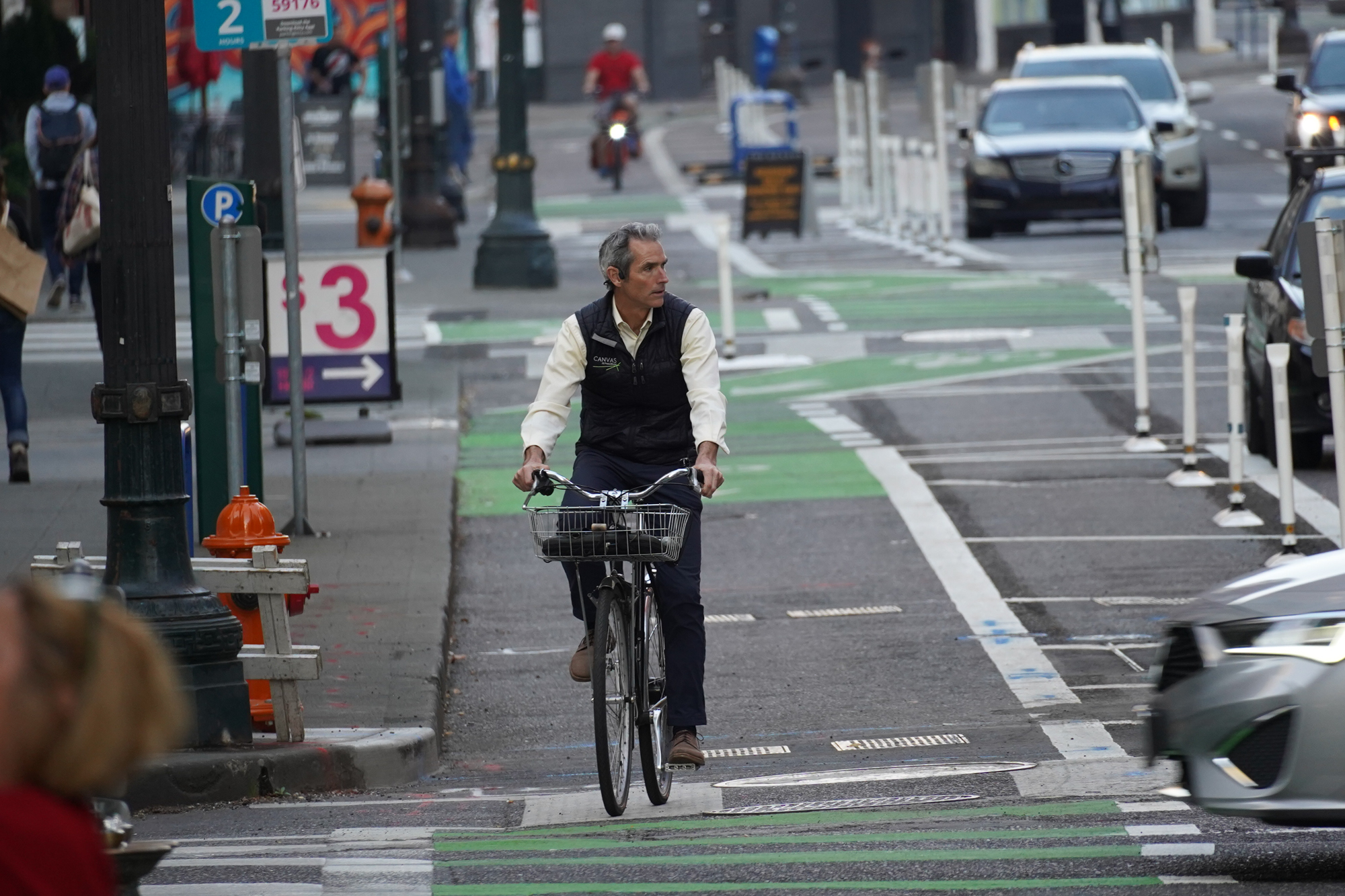
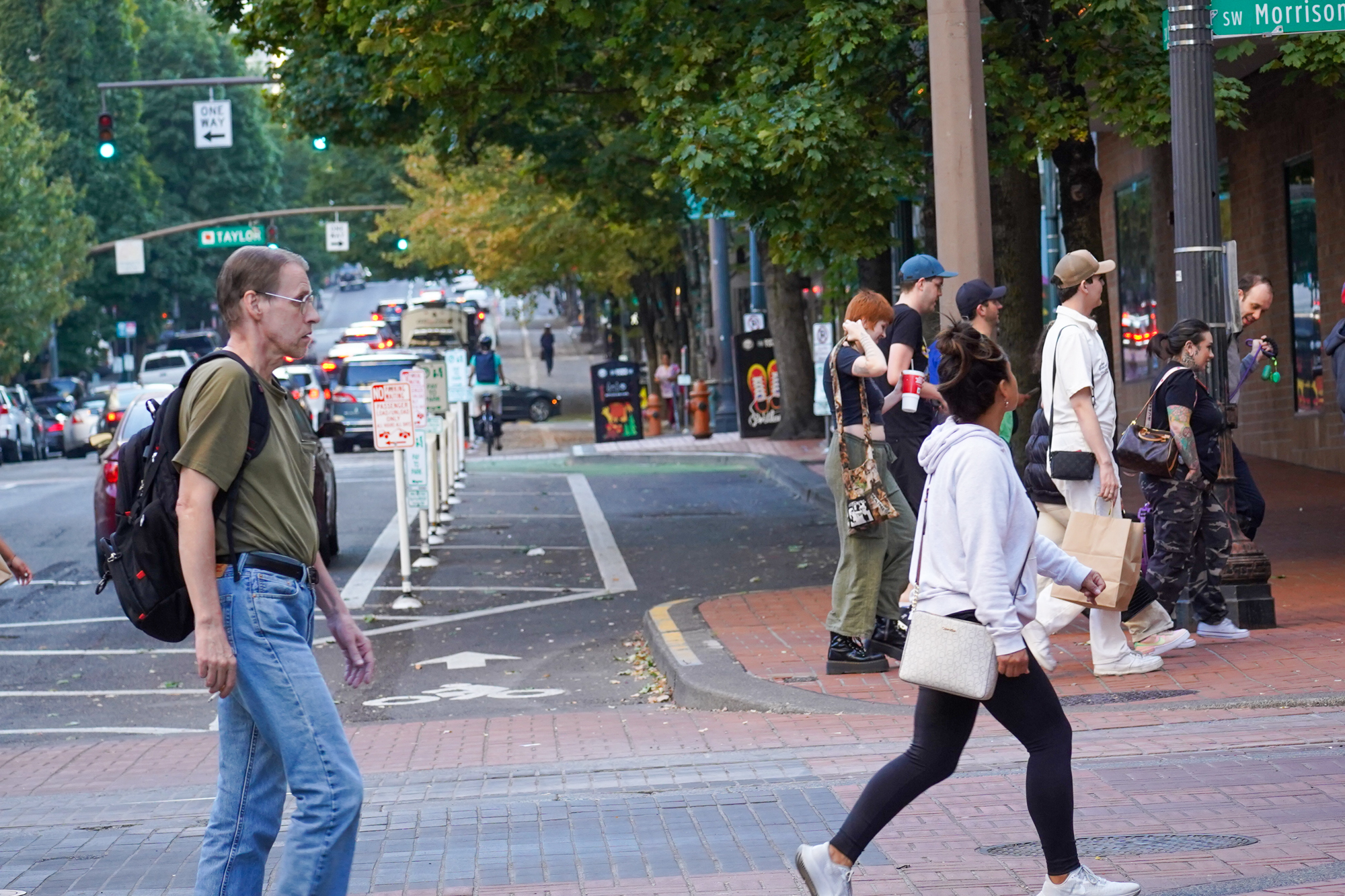
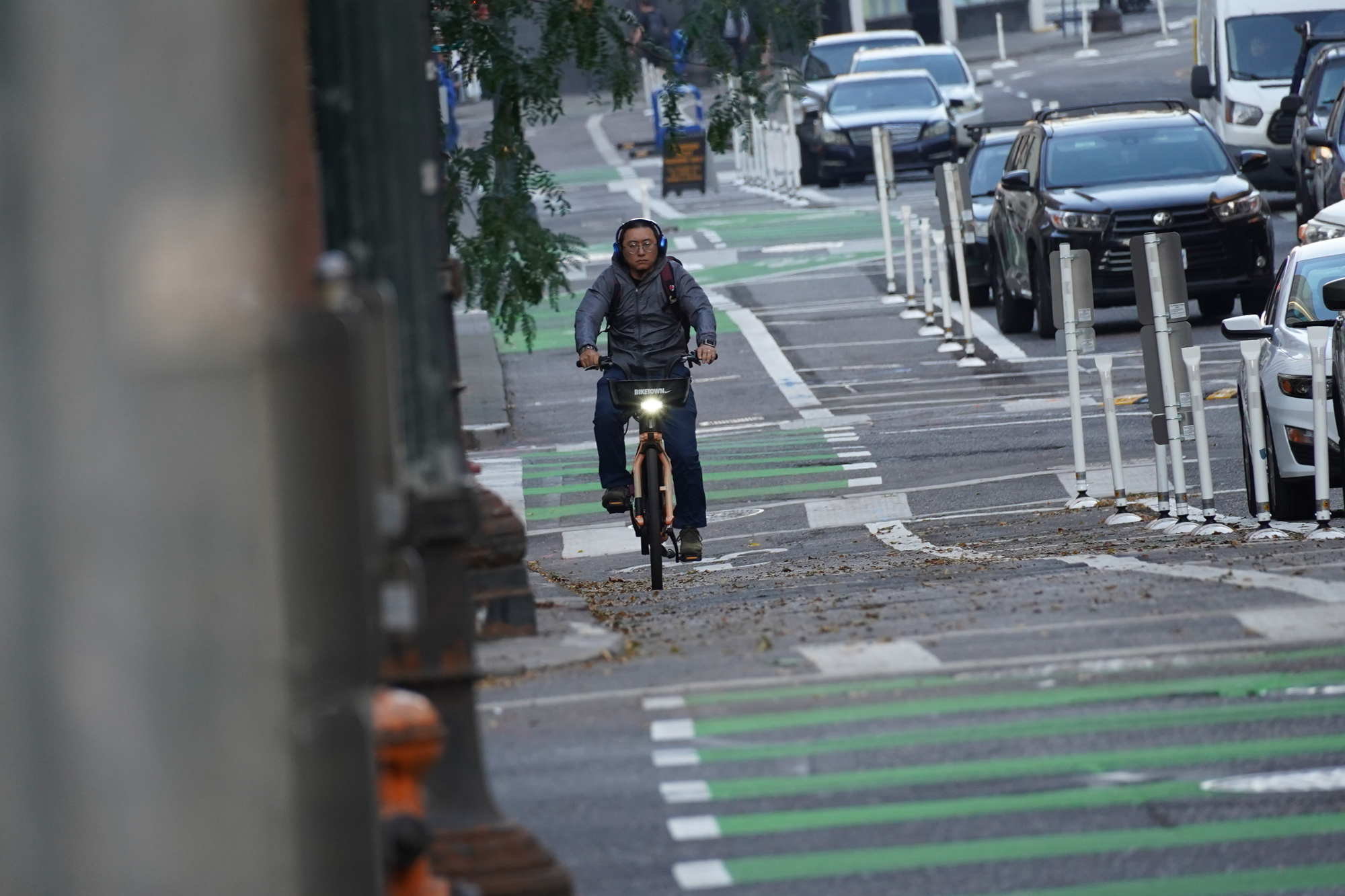
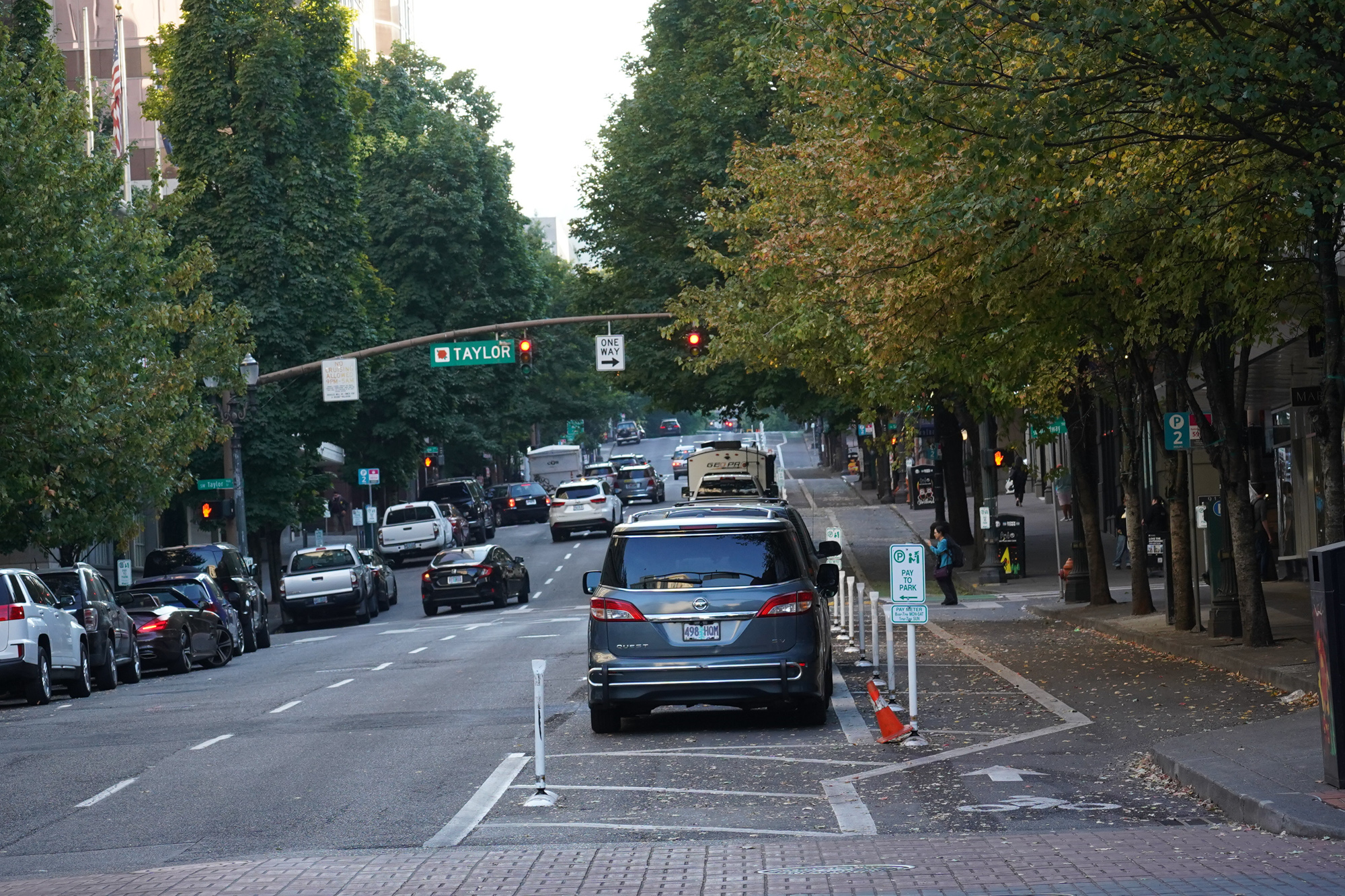
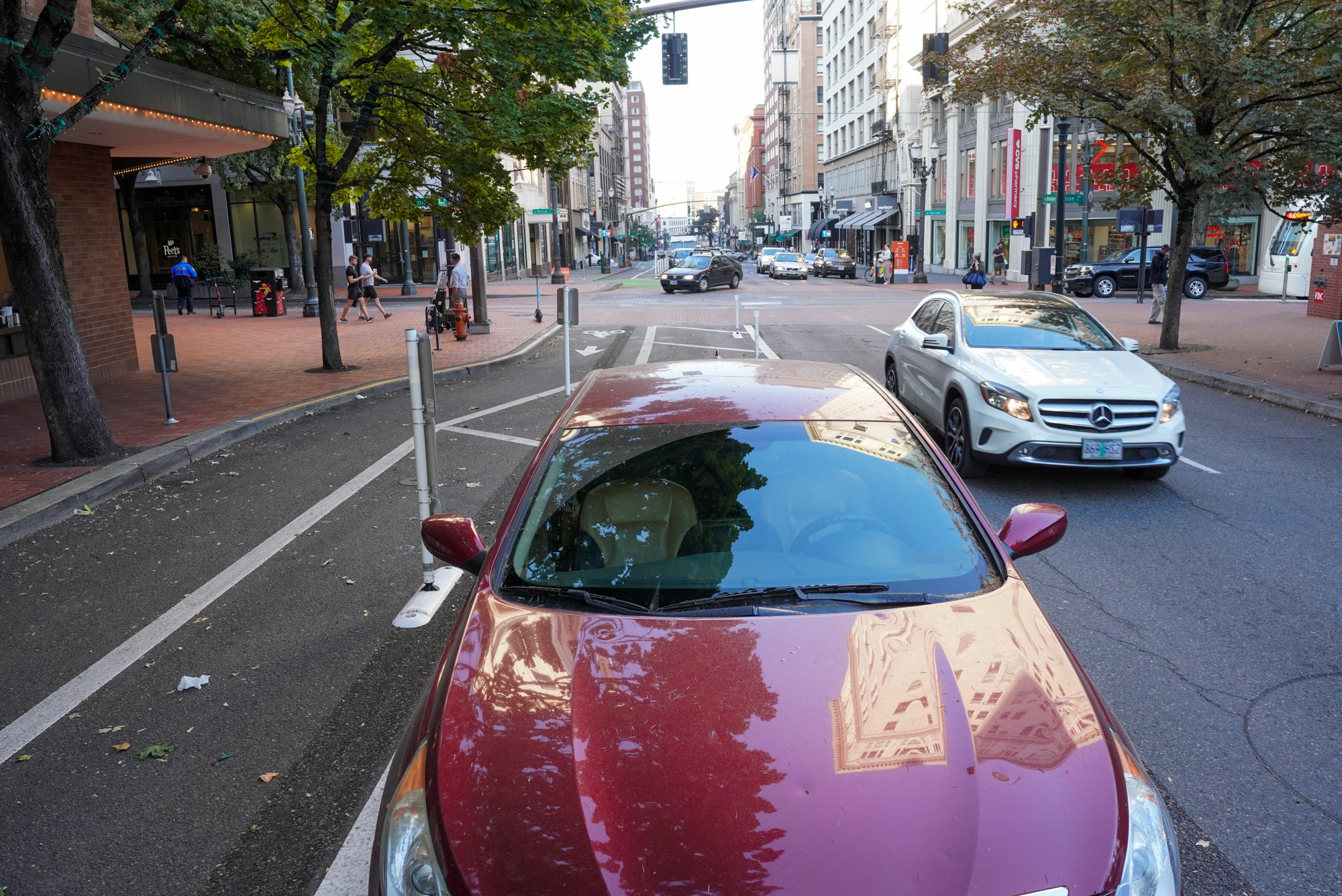
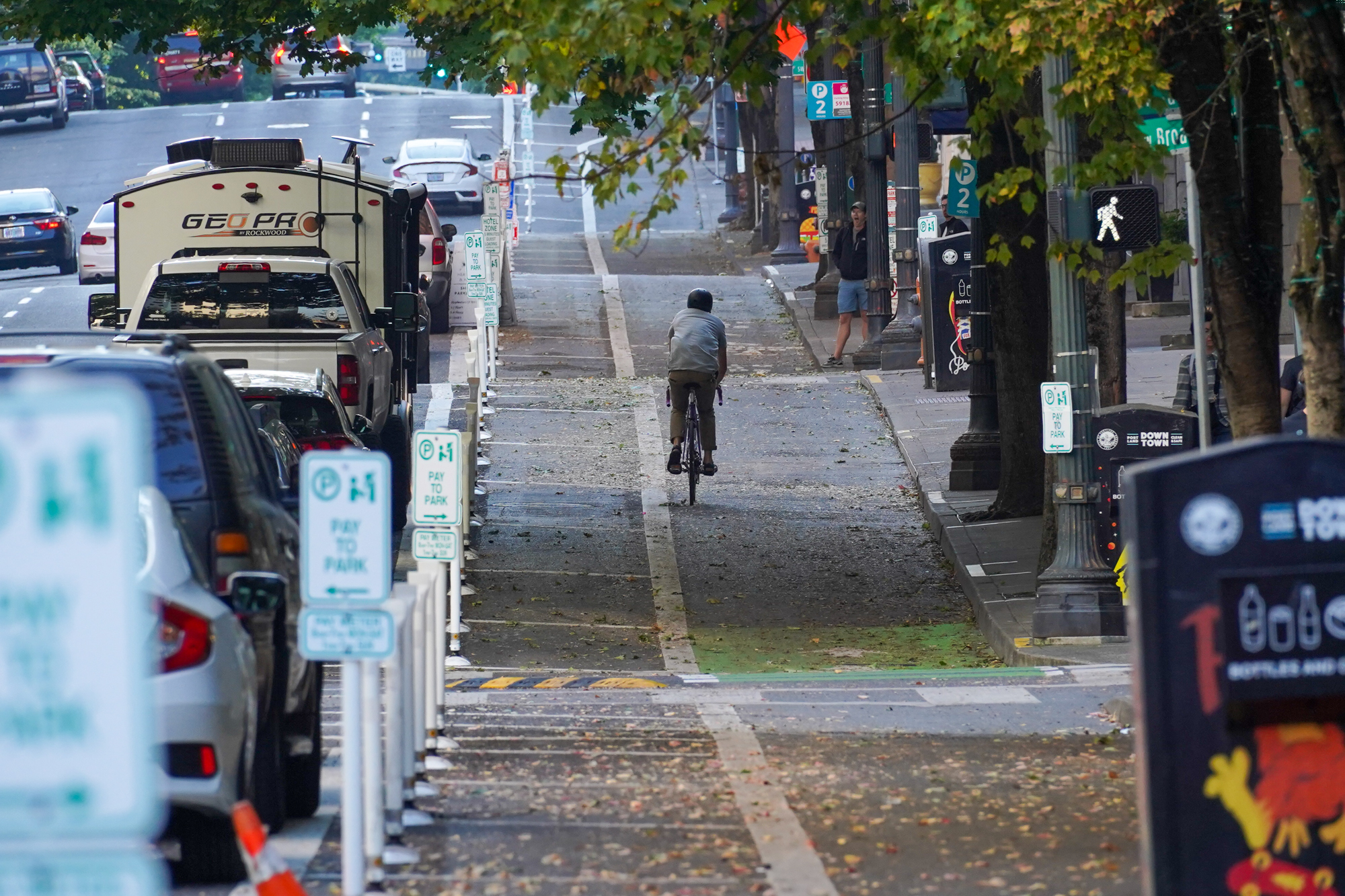
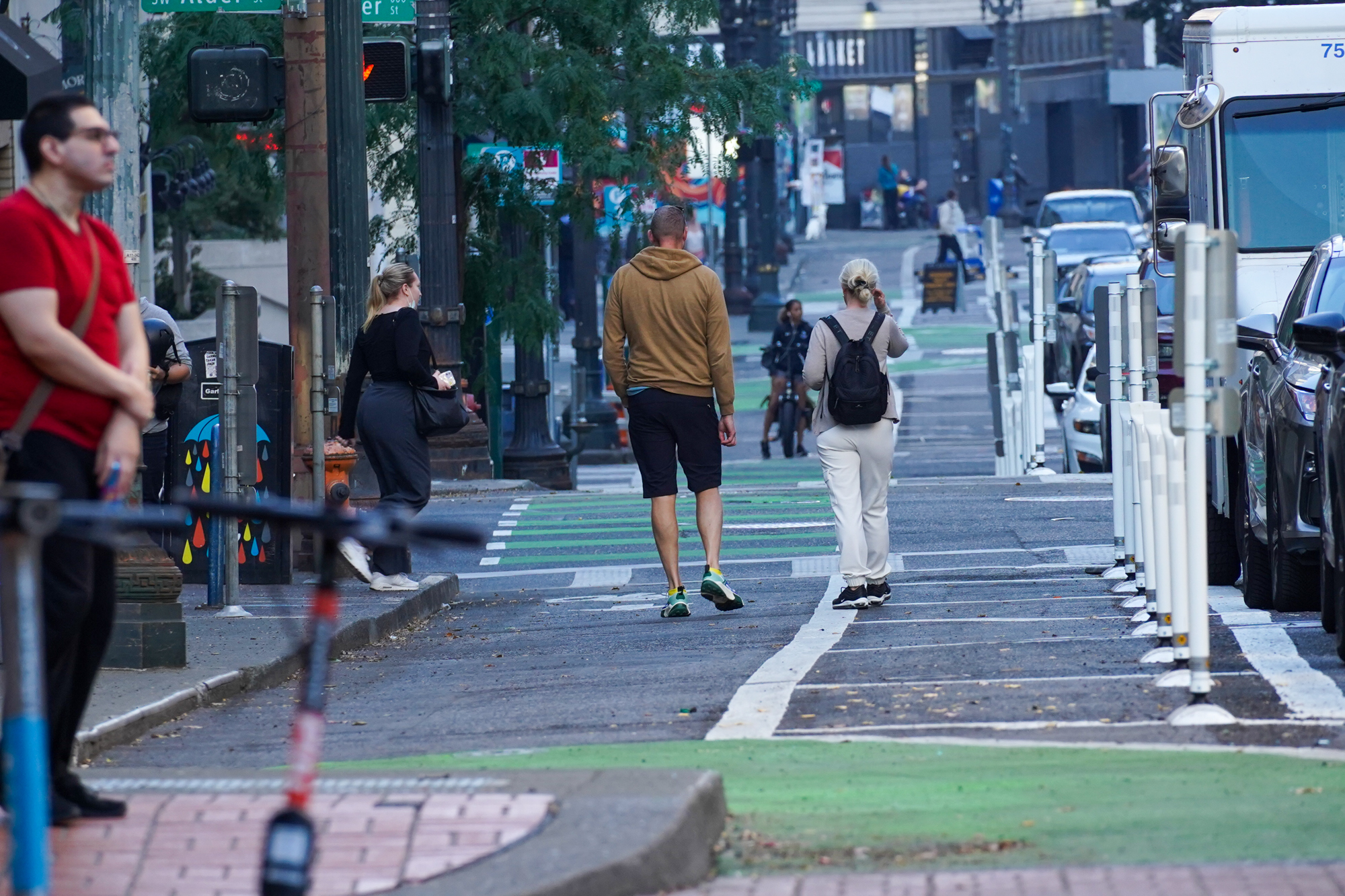
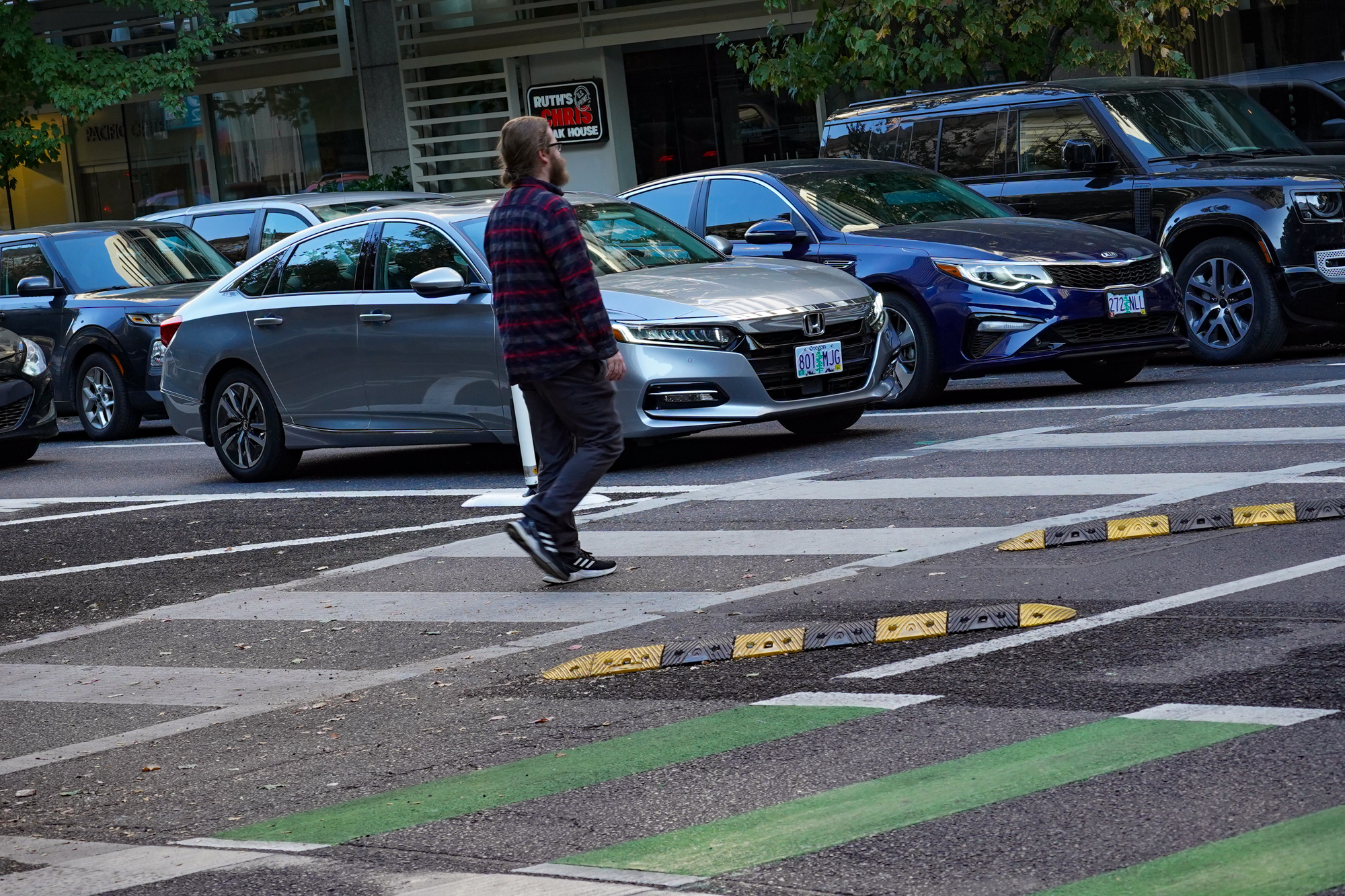
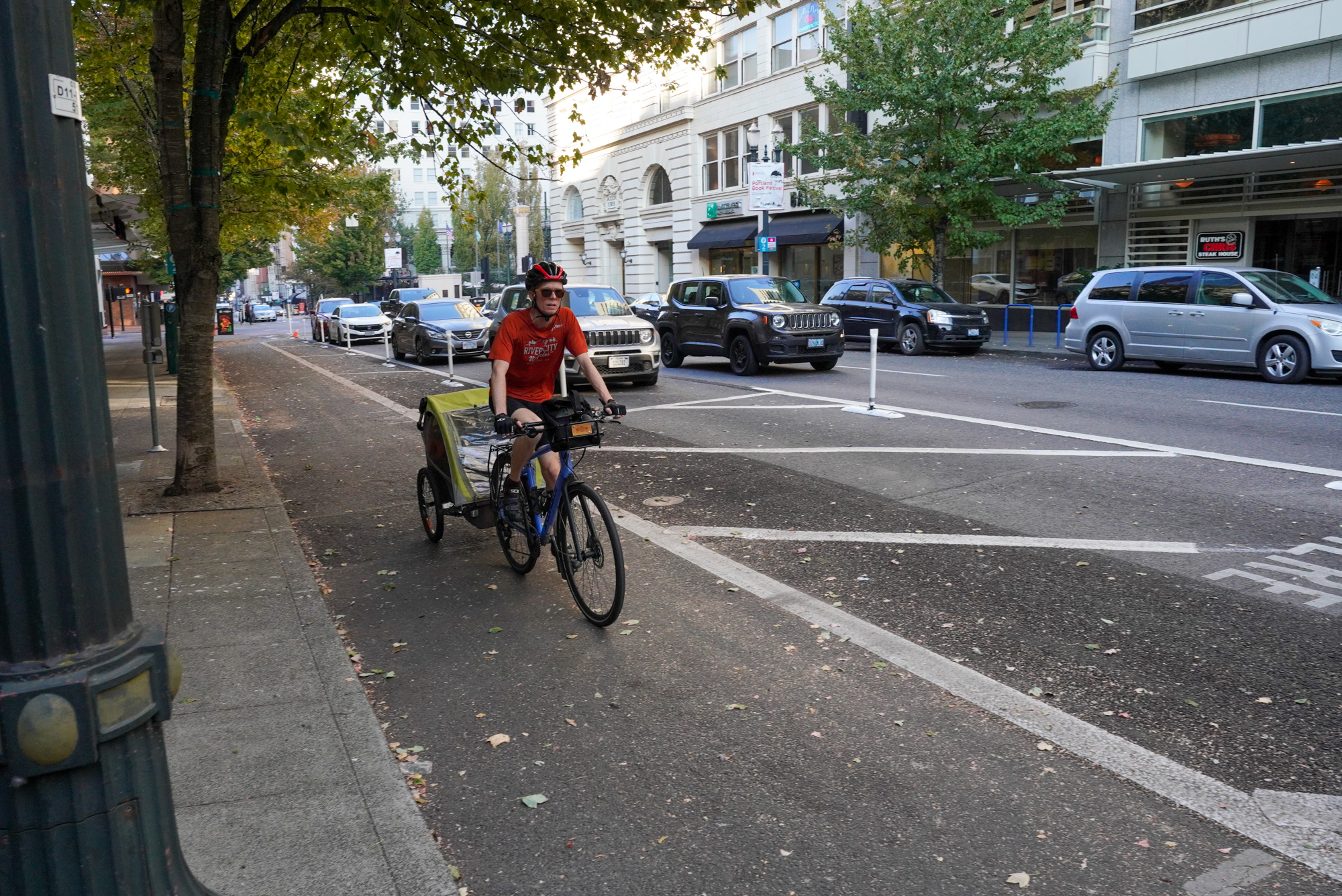
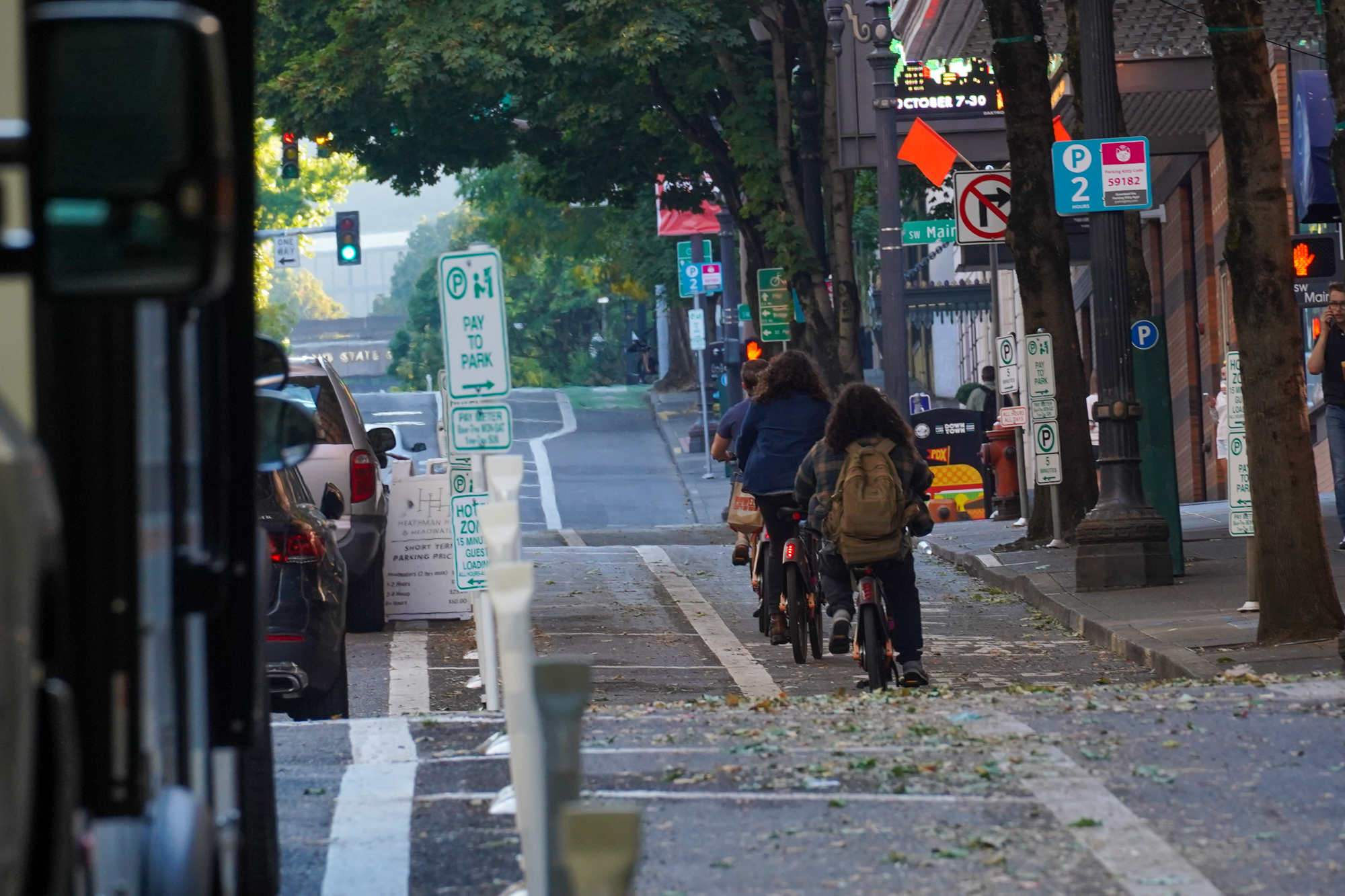
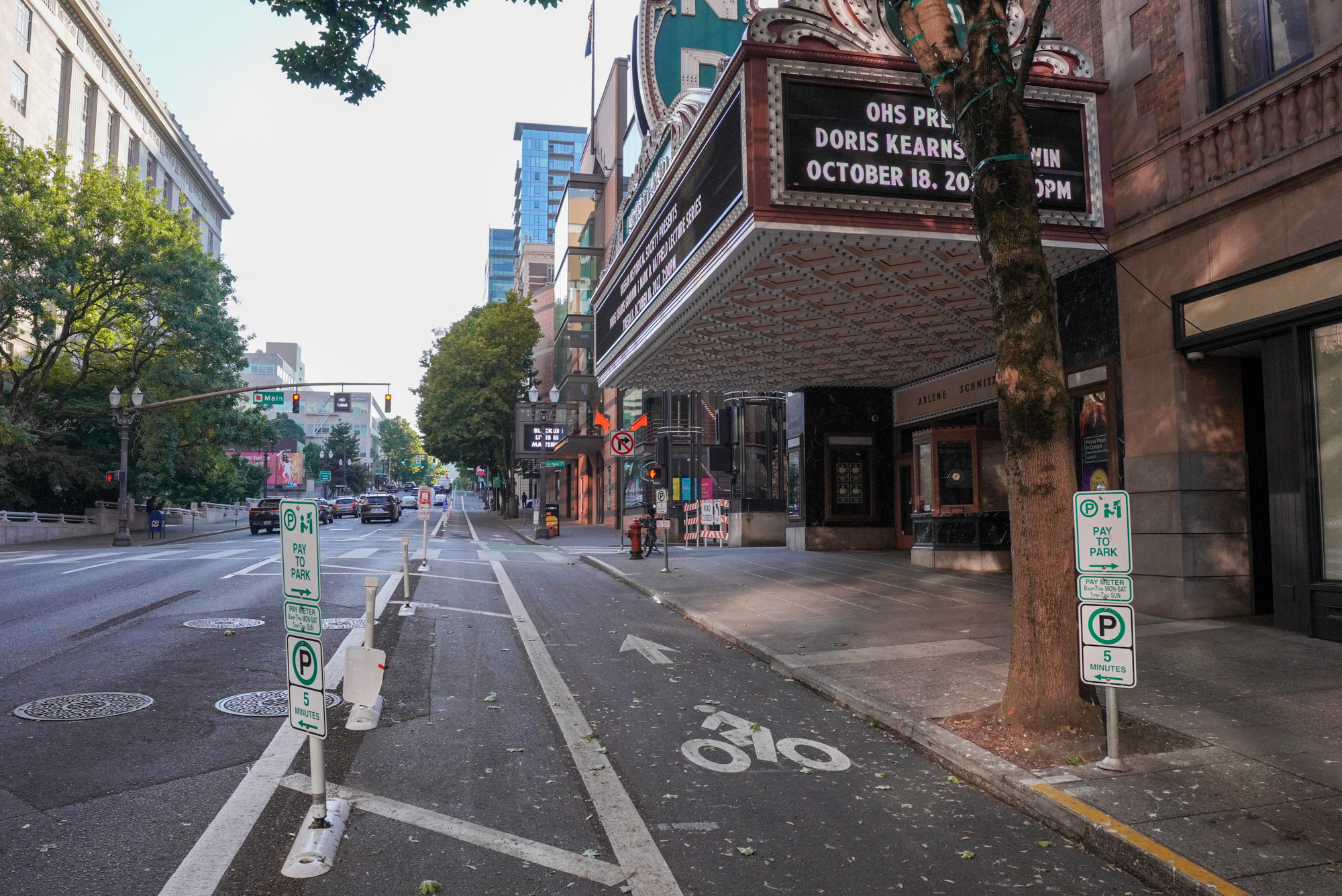
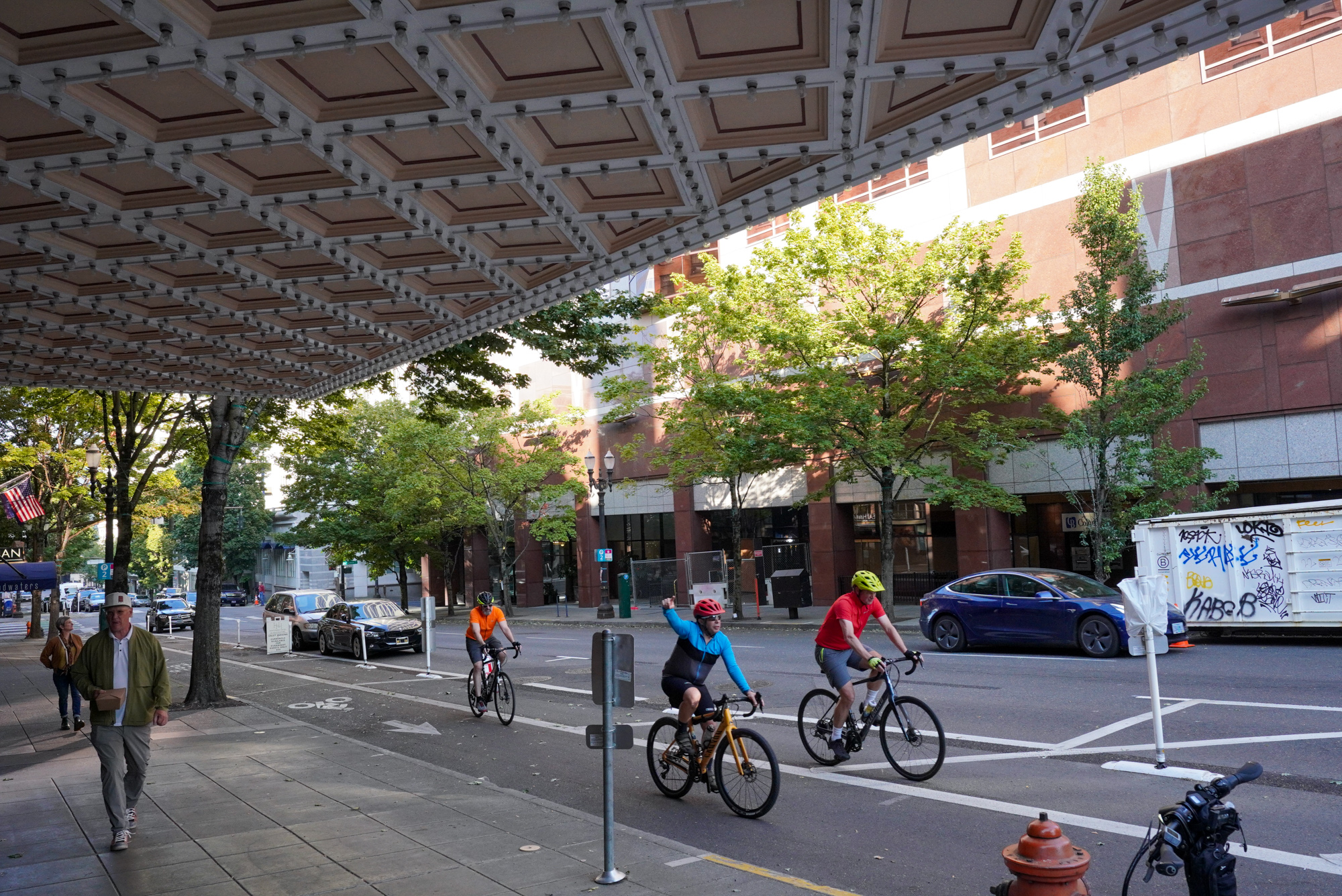
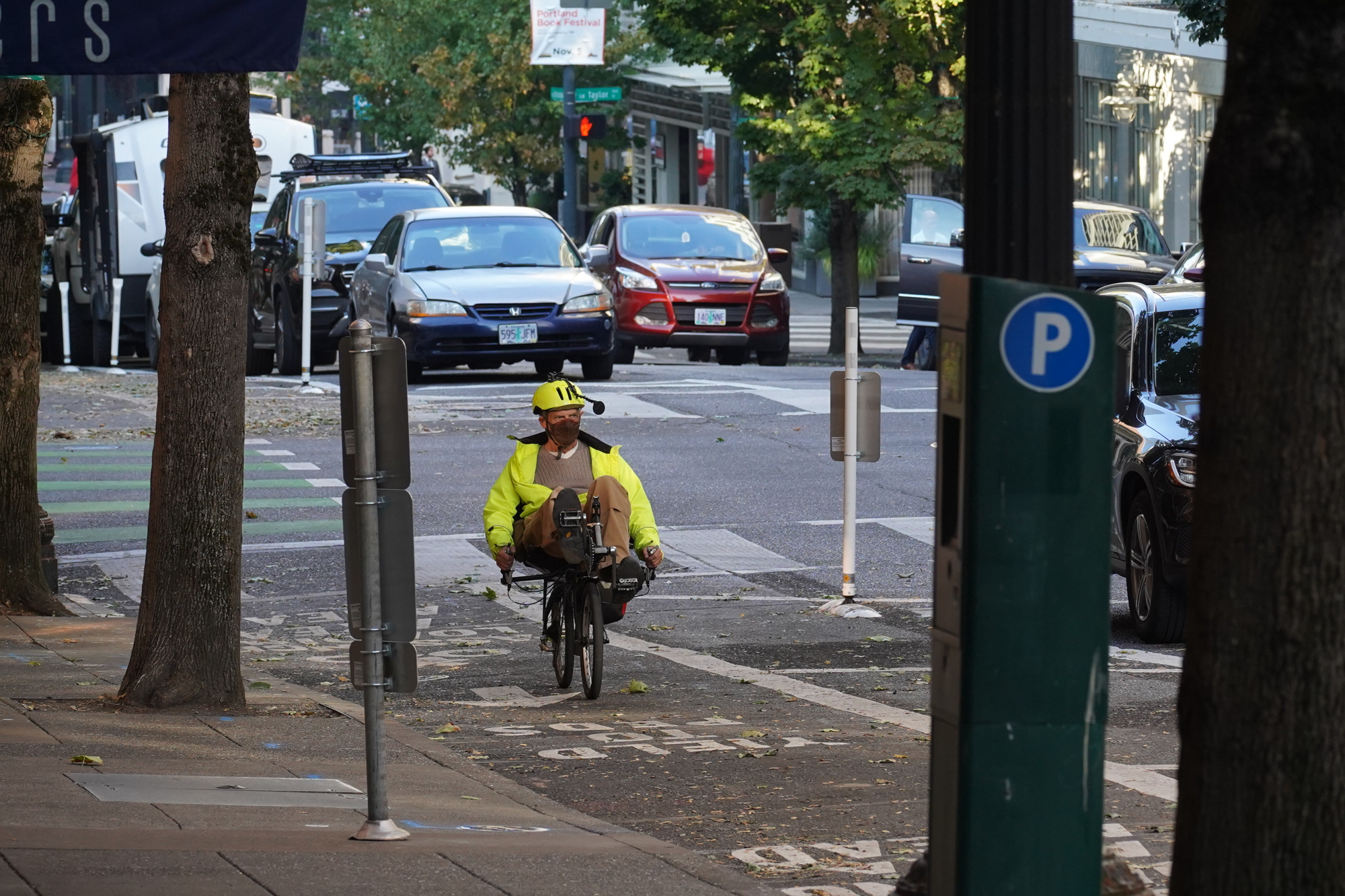
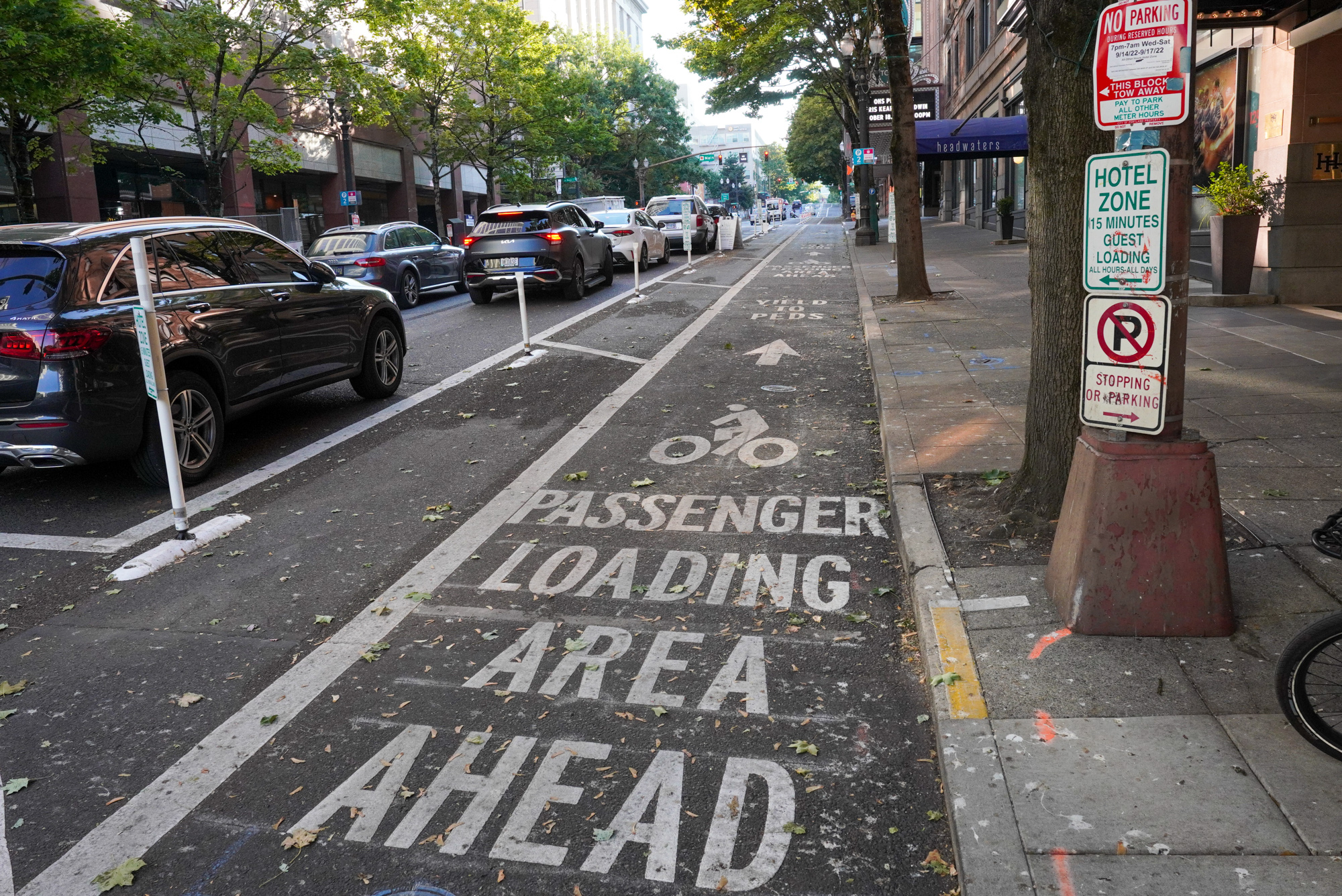
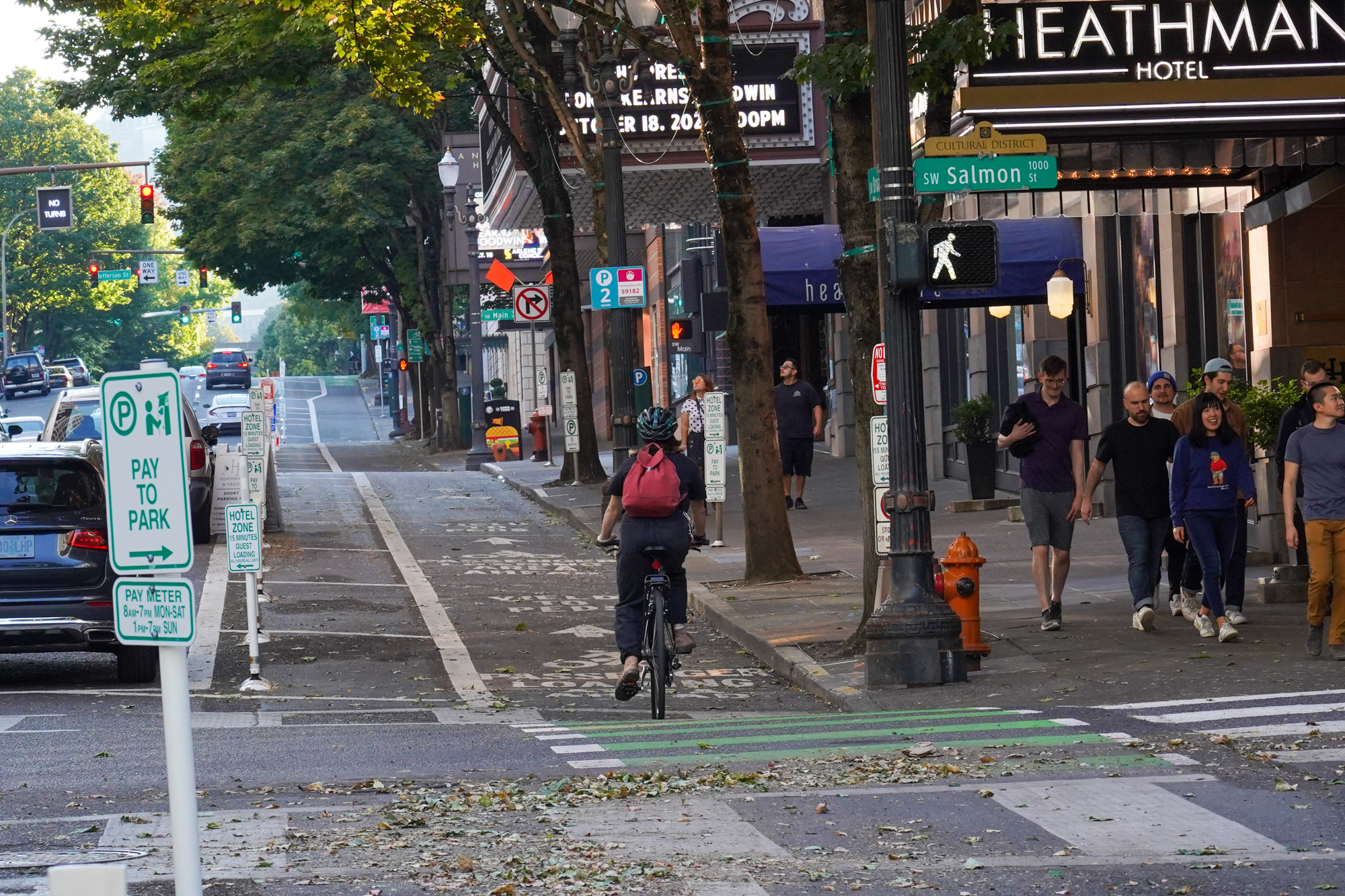
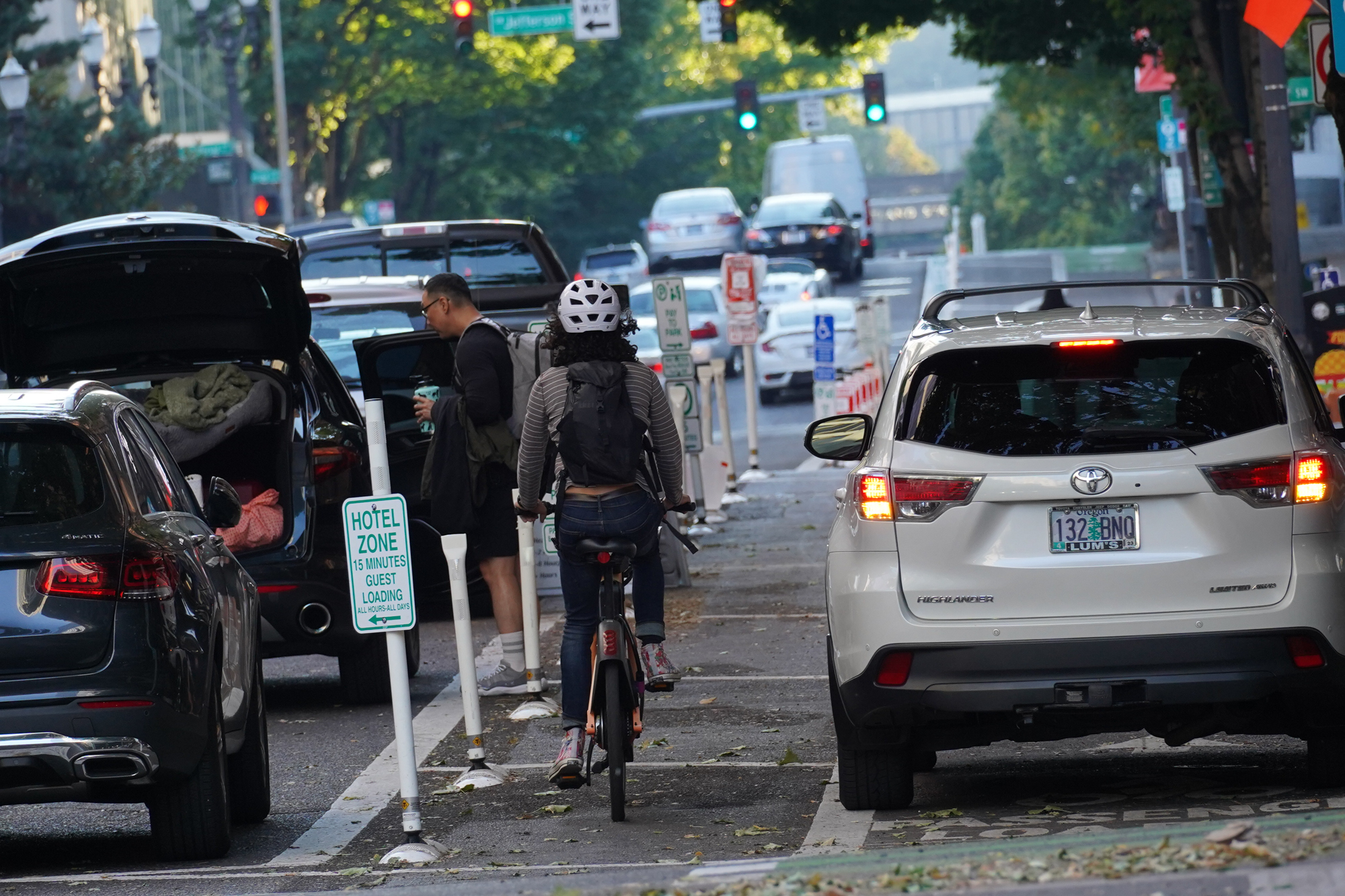
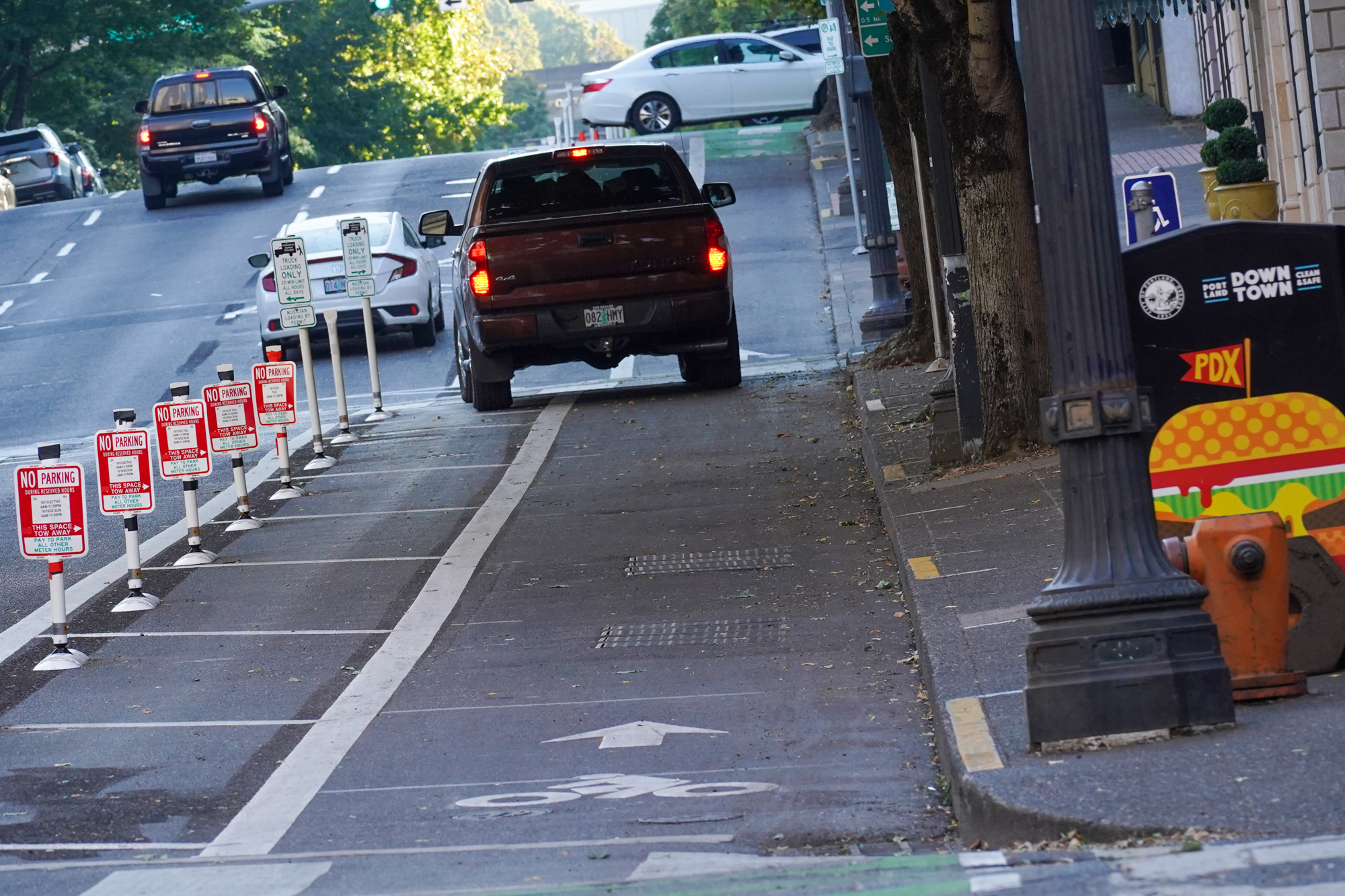
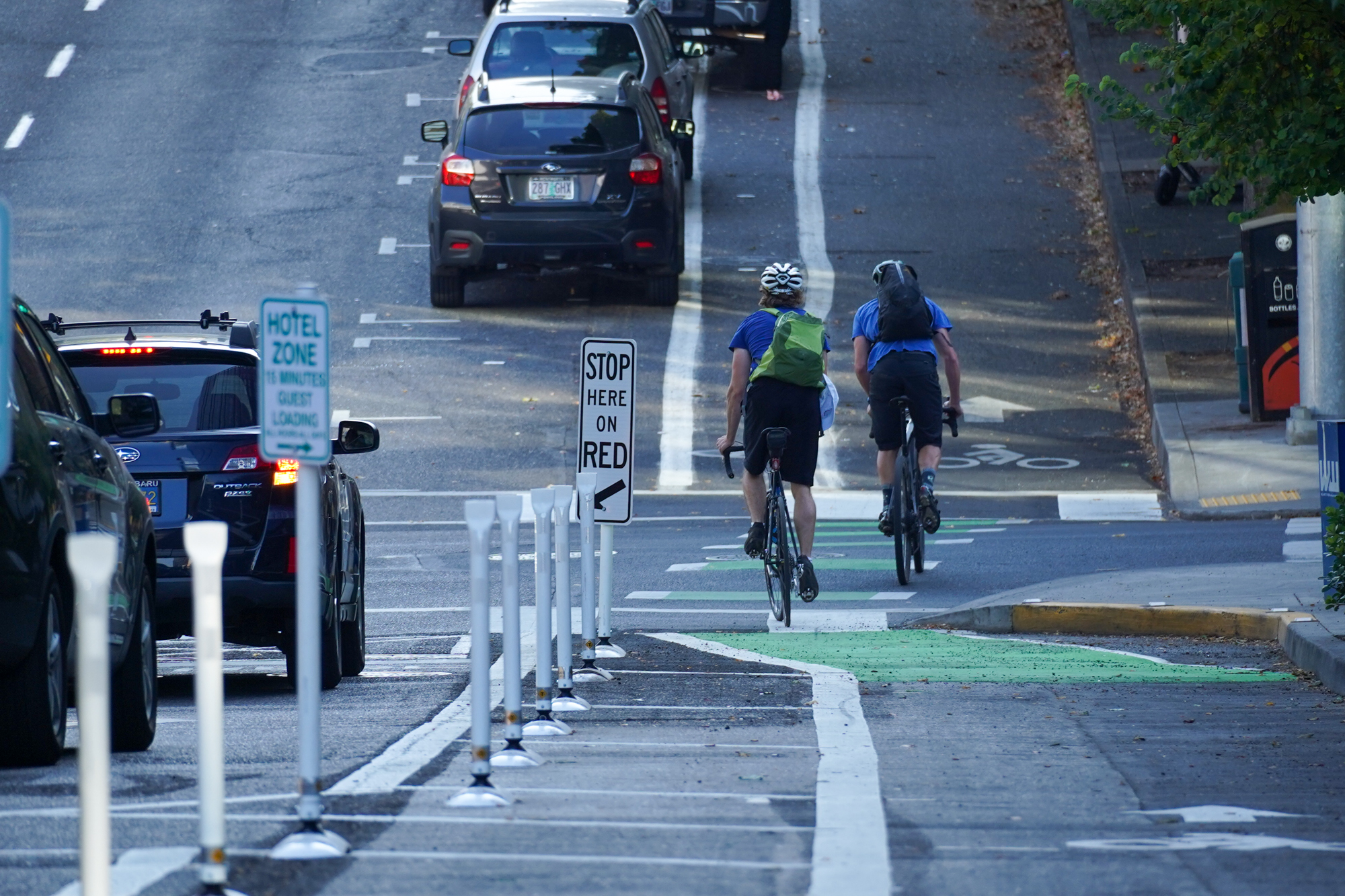
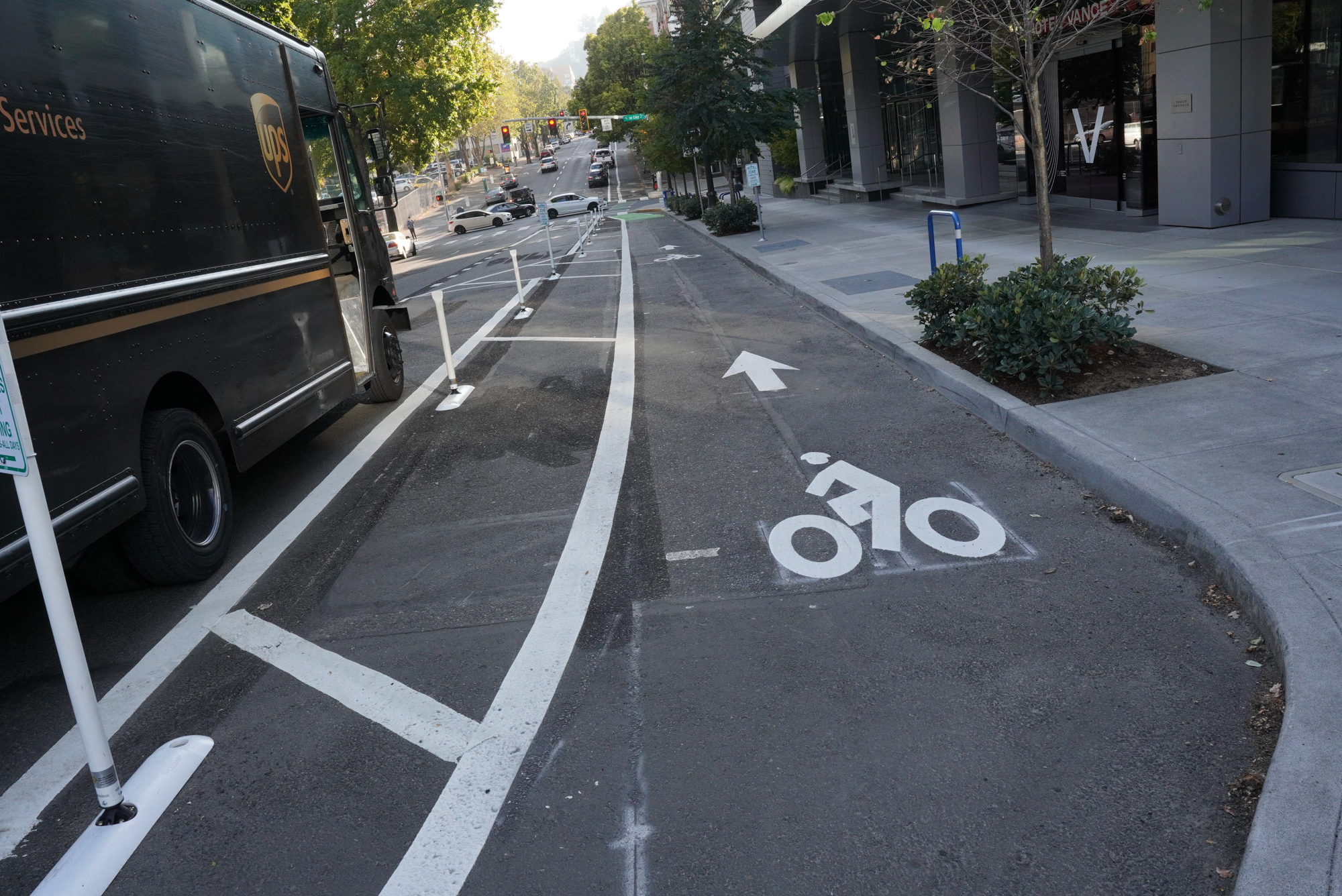
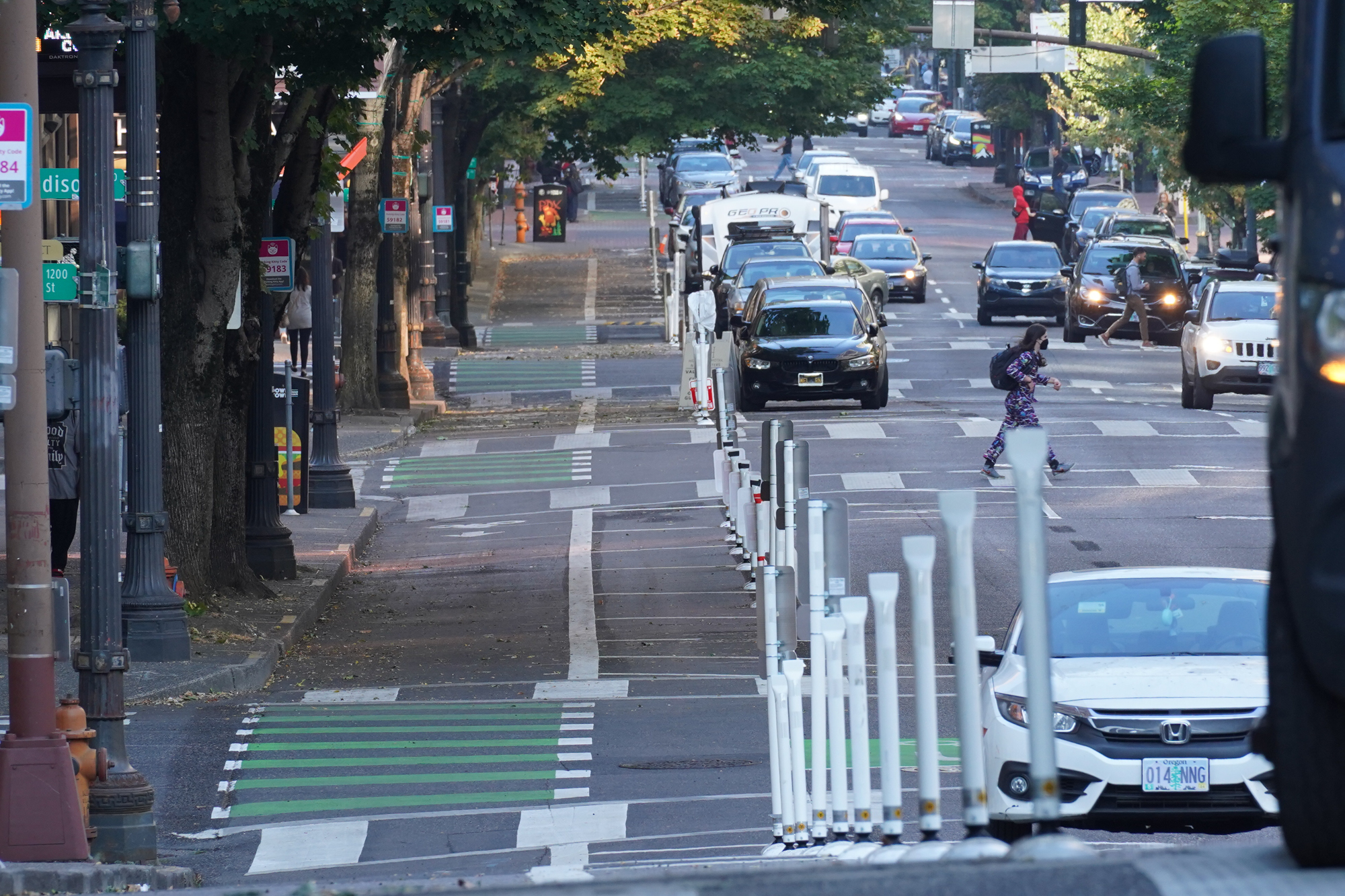



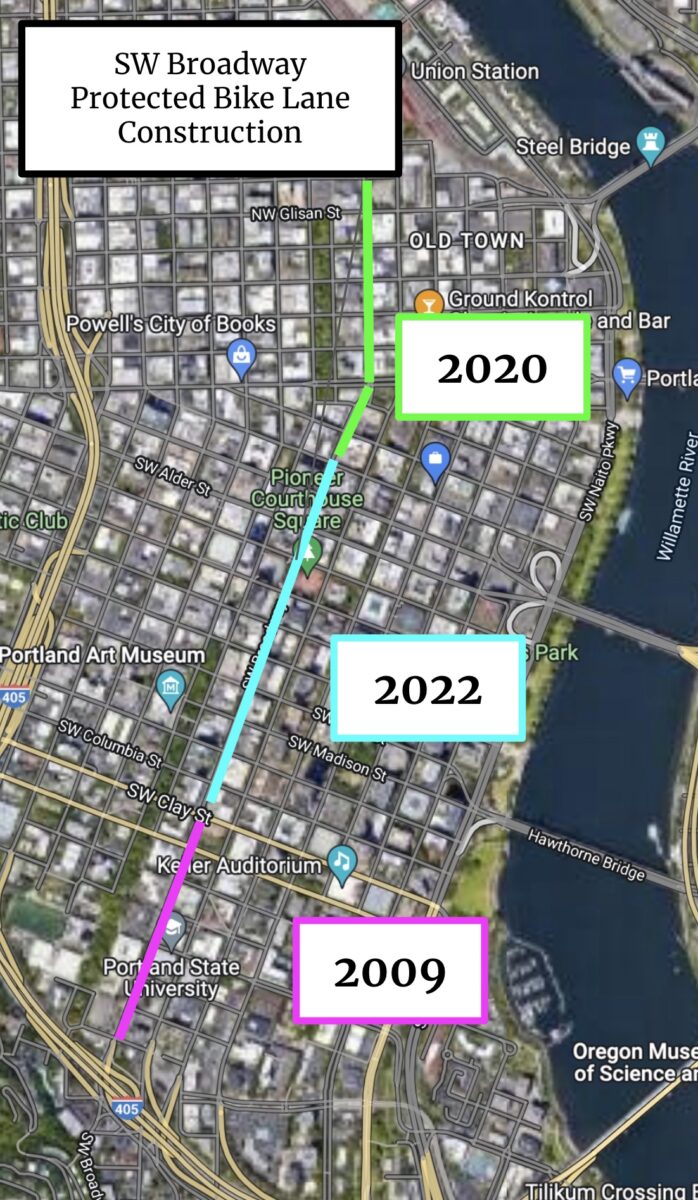
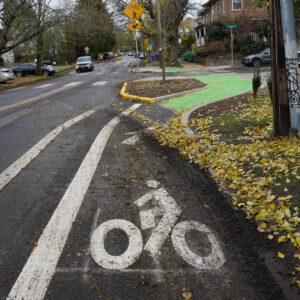
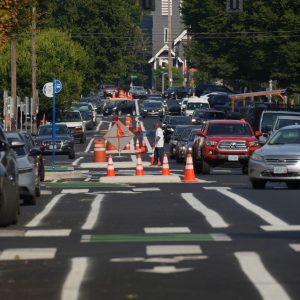
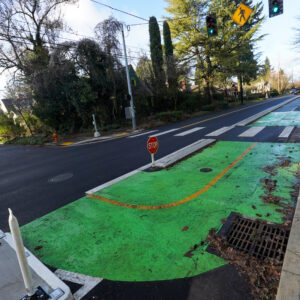
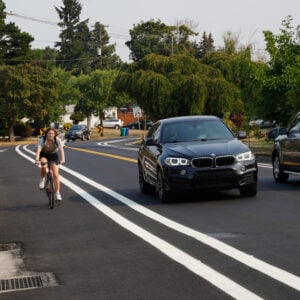
Thanks for reading.
BikePortland has served this community with independent community journalism since 2005. We rely on subscriptions from readers like you to survive. Your financial support is vital in keeping this valuable resource alive and well.
Please subscribe today to strengthen and expand our work.
Thanks for posting this with all the thoughts, background and photos. I do hope the city finds a way to remove leaves and garbage from the protected lanes, since they are cut off from the main traffic lane. The protected lanes in Chinatown are often rendered useless by leaves and garbage.
I’ve ridden on it several times and I’d say it’s one of the most comfortable places to bike downtown. I wish they’d hurry up on improving Alder, because once they do my connection to the Hawthorne bridge from my apartment in the NW district will be mostly safe and comfortable feeling
This is fantastic. I remember when the first section opened – lots of riders hated it for hate’s sake, but it was exciting and felt like we were really getting somewhere. I loved stopping almost every day to tell a driver they were parking in the new cycle track.
I work on Broadway and rode this section a lot before the changes. The new lane is a huge improvement. In addition to doors, cars would swoop across the bike lane to park. I had a couple of run ins that way. Overall, it’s way a more pleasant ride without having to be as hyper vigilant for doors and right turns.
Huge, huge improvement. I ride it every day on my commute home from Pioneer Courthouse Square through PSU. The biggest problem is the bike signal at Clay. Drivers are often ignoring the the right turn red signal. Moreover, the green bike phase far too short, as a result I run the signal rather than waiting minutes of the next phase. PDOT needs to retime the signals.
It’s a huge improvement and I’m excited for the companion project on SW 4th. The changes obviously make it much more comfortable to cycle on Broadway, but it feels noticeably easier to cross the street on foot; I hope that one day the implied pedestrian islands at the floating parking lane can be hardened with concrete.
Good point. An interim intervention could be planters or pots at intersections. I would love to a see a streetscape plan that included street trees and lighting moved outboard into the door zone on parking lane.
Nice expansion! I’ve been using the original section to ride between downtown and OHSU ever since it opened in 2009. Now if they could just find a way to widen the very narrow bike lane at the start of SW Terwilliger Blvd before that road loops around at the Shell station to go up the hill to OHSU.
I agree, the fact that you have to take the lane around a blind corner to get into the turn lane is a huge turnoff for me. Broadway is a great piece of bike infra with terrible connections on the south side. It is one of the few ways to get to the largest employer in Portland and to the rest of SW Portland.
Are there bollards to block cars from using the new extra wide lanes as traffic or parking lanes?
Nope, and you can see that there are already cars in the the bike area in the last gallery of photos.
I just got back from a couple days in Charlotte NC. They used to have a lot of car drivers parking illegally in their protected bike lanes, both the candlestick and concrete curb types, but the city put in lots of bright yellow bollards all over the place, so now the main hazards are joggers and dog walkers. The city does a very good job keeping their bike facilities very clean and garbage-free, even away from downtown, and many of the trails and protected bikeways even connect to places now, rather than run randomly like they do in most NC cities. The city is a lot like Portland now, except richer (full of bankers), a bit bigger, and some of the buildings there make Big Pink look small. Car drivers are just as bad and aggressive. I even came across a good-sized 6-way roundabout that really works well, on Tuckaseegee, for both cars and bicyclists.
I wish there was more raised dutch style bike infra, if cars had to go up to sidewalk level to cross bike paths it would feel much safer and help cars recognize when they were intruding on someone elses space
Perfect is the enemy of good.
That’s what PBOT is hoping for.
Choosing not to do the good because it’s not perfect is bad. But making what’s already good better is good, and making it perfect is better. Nick’s comment about making the good better is perfect.
Perfect takes 20 years to design and implement, it costs a lot more even with a federal grant, and by the time it’s completed it’s already completely out of date. Good is cheaper, unfortunately in every sense of the word. Mediocre is usually what we get, alas, the same old s**t as usual.
“The design does so much more than protect bike riders. Because moving car traffic is now about 20-feet from the curb, there’s a much quieter and calmer feeling on the sidewalk.”
This is what I like best about this project. It’s a huge side benefit, for all the reasons–more breathing space, more potential for outside dining, shorter crossings–that you mention.
I’d also love seeing trees added between the bike lane and parking, raised pedestrian islands, etc. that others have mentioned.
… until that space is subsequently occupied by illegal campers, construction crews who force pedestrians into the bike lane, illegally parked cars and delivery vans, legally but unethically parked city vehicles, bike chop shops, Bird scooters, food trucks, sandwich boards, dog (and human) poo, garbage, unkempt flora, flattened fauna, and all the other clutter that make pedestrians’ lives miserable.
That seems unduly pessimistic. The improvement isn’t coming from widening the sidewalks, it’s from adding the bike lane in between the sidewalk and the parked cars, so the sidewalk is buffered from the noise and movement of vehicles. Most of the things you list have been minor issues at most on Broadway (which is why you don’t see much of any of those in the photos above) and moving vehicle traffic further from the sidewalk shouldn’t make them worse. The exception could be vehicles parking in the bike lane.
Wow, that guy parallel parked his 25ft travel trailer on the street downtown? Bold move. I wouldn’t dream of even trying to drive through downtown with our tiny trailer.
I ride the new section on my way to work and it’s a huge improvement! Parking in the bike lane is an ongoing issue. Now I just wish there was a north-bound street with the same feel or more/better connections between Broadway and Naito!
Construction on the CCIM Fourth Avenue protected bike lane is supposed to start next year.
The hotel zone was always the biggest problem on the years I had a bway commute. Thanks for calling that out.